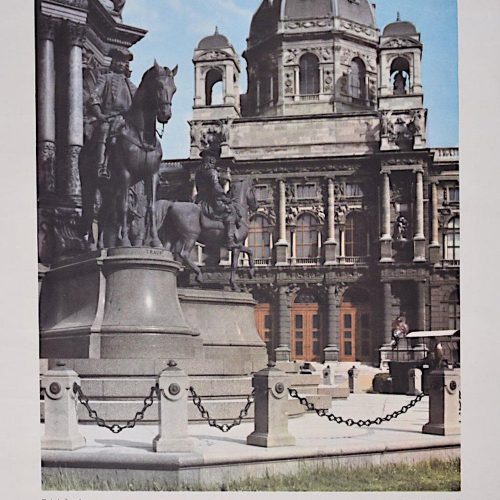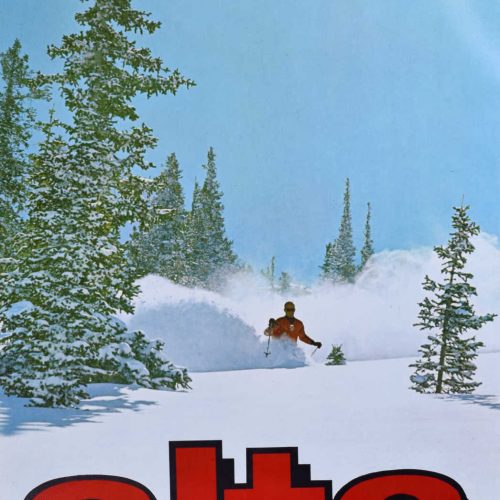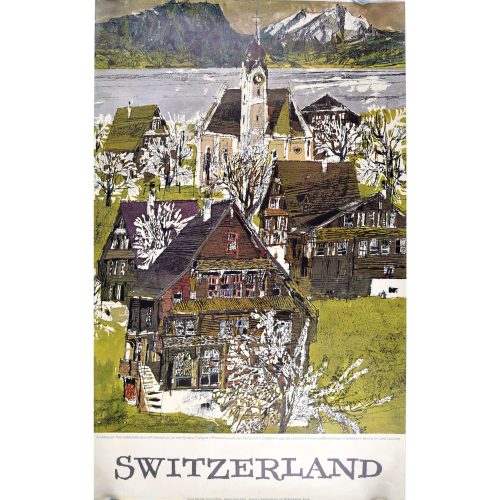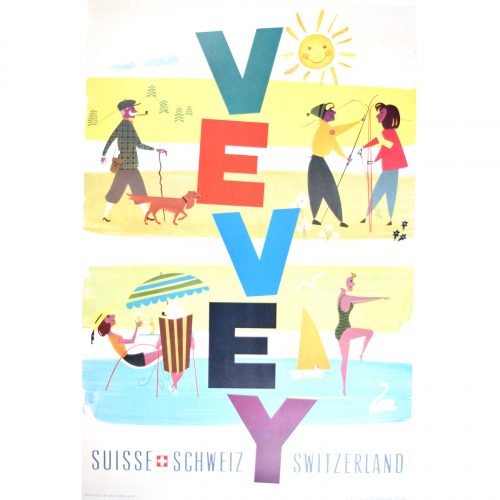-
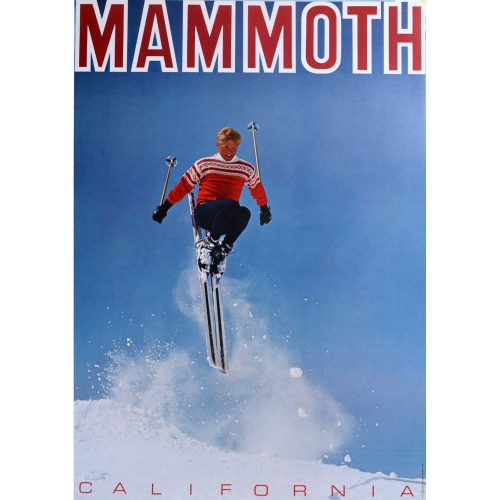
Mammoth Mountain California Vintage Ski Poster (1967)
67 x 53 cm Printed by LooArt Press, Colorado Springs, Colorado. Vintage travel poster for Mammoth, California ski resort. Includes an illustration of a skiier gliding through the air. Direct from the surplus stock of the printers, LooArt Press, which closed in the early 1970s. Condition: Excellent -
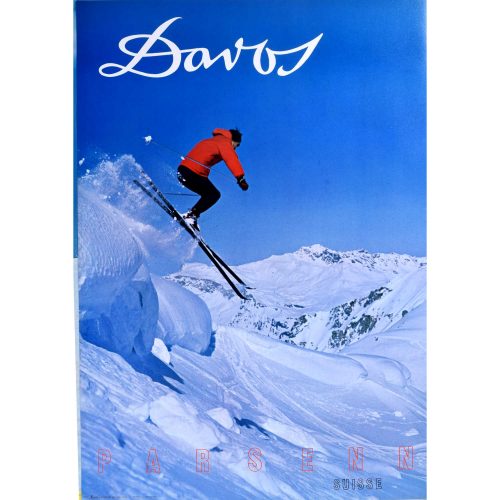
Davos, Parsenn Region, Switzerland Vintage Ski Poster (1968)
67 x 53 cm Printed by LooArt Press, Colorado Springs, Colorado, 1968 1960s poster for Davos ski resort in Parsenn, Switzerland, featuring a photograph of a skiier jumping off the slope into powder snow. Direct from the surplus stock of the printers, LooArt Press, which closed in the early 1970s. Condition: Excellent -
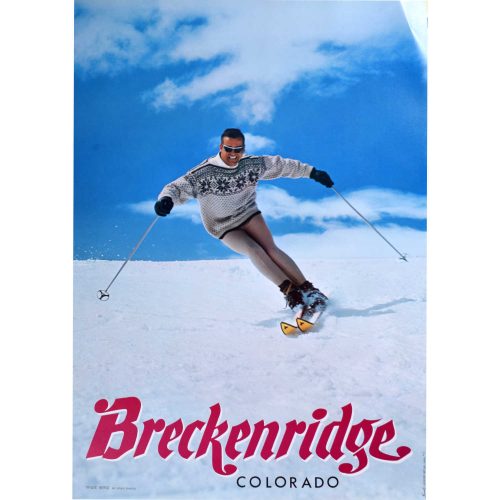
Breckenridge, Colorado Vintage Ski Poster USA (1967)
67 x 53 cm Printed by LooArt Press, Colorado Springs, Colorado, 1967 Travel poster for skiing in Breckenridge, Colorado, featuring a photograph of a smiling skier - Trygve Berge sporting Kneissl skis - and a rather cool pair of shades and jumper. Direct from the surplus stock of the printers, LooArt Press, which closed in the early 1970s. Condition: Excellent. -
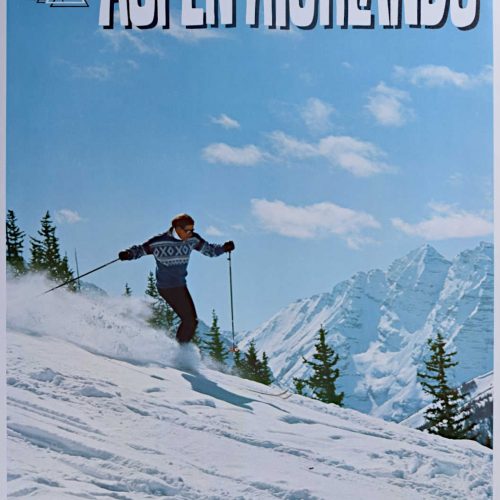
Aspen Highlands Vintage Ski Poster (c.1970) Maroon Bells Mountains
67 x 53 cm Poster Printed by LooArt Press, Colorado Springs, Colorado Direct from the surplus stock of the printers, LooArt Press, which closed in the early 1970s. Condition: Generally excellent, new-old stock from the 1970s printers. -
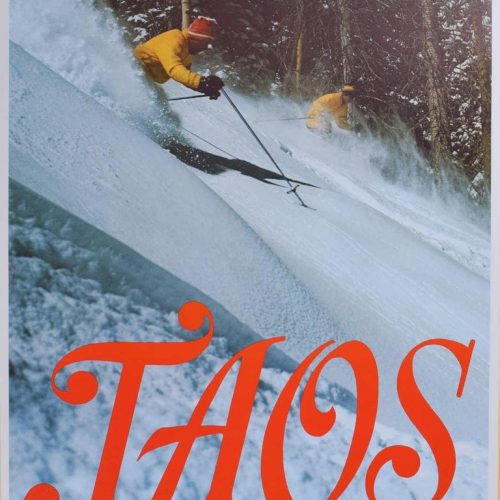
Taos New Mexico USA Vintage Ski Poster 1974 Victor Frohlich and Tom Carrera
67 x 53 cm Poster Printed by LooArt Press, Colorado Springs, Colorado Direct from the surplus stock of the printers, LooArt Press, which closed in the early 1970s. This features Victor Frohlich in the foreground, who had been at Taos Ski Valley since the start, with Tom Carrera in behind him. This is on the Snakedance fun in 1974. Taos Ski Valley was founded in 1955 by Ernie and Rhonda Blake who lived in an eleven foot camper van prior to the construction of the Hondo Lodge - now the Inn at Snakedance (where they lived without power until 1963!) In 1956 Ernie - together with sixteen men from Taos Puelbo and a mule named Lightning - installed the first lift, the Bridger-Boseman J-Bar, serving the current Snakedance run which at the time was the mountain's only run. Condition: From the printer's surplus stock, in generally excellent condition. -
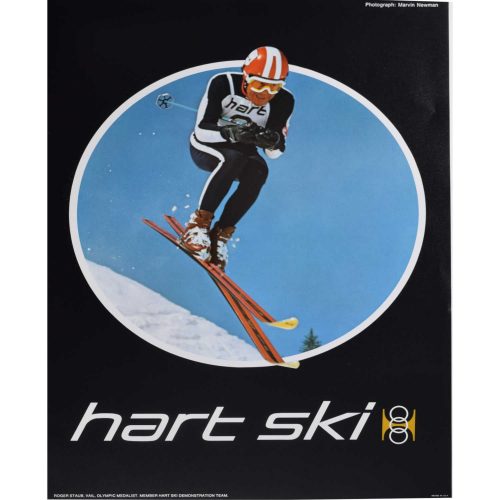
Hart Ski Colorado Original Vintage Poster (c.1970), Roger Staub USA
67 x 53 cm Made in U.S.A Photograph of Olympic Medalist, Roger Staub, photographed by Marvin Newman. Born in 1936, Staub won the gold medal in the Giant Slalom in the 1960 Winter Olympics in Squaw Valley; his first Olympics having been in 1956 where he finished fourth. Following a brief career as a professional racer he commenced a life as ski school director at Vail, Colorado, just after its opening. He died in 1974 in a ski gliding accident. Condition: Generally excellent, direct from the surplus stock of the printers, LooArt Press, which closed in the early 1970s. -
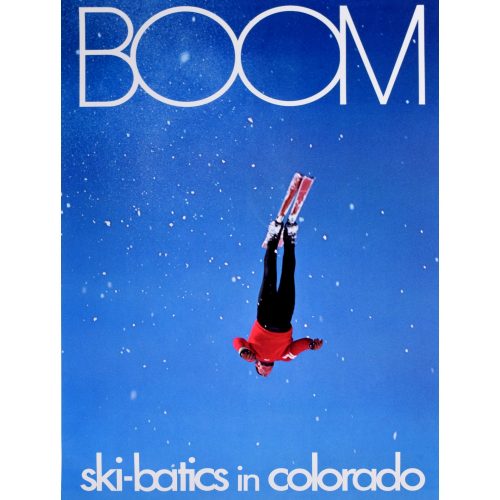
'BOOM' skibatics in Colorado Poster (c.1970)
67 x 53 cm Original Vintage Poster Printed by LooArt Press, Colorado Springs, Colorado. Features a photograph of acrobatic skier by Steve Knowlton. Direct from the surplus stock of the printers, LooArt Press, which closed in the early 1970s. In generally excellent condition. -
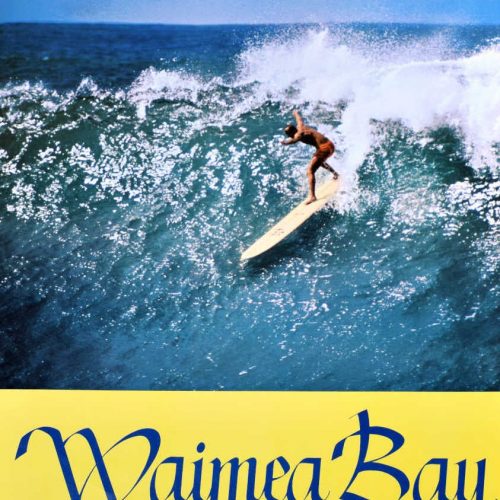
Waimea Bay, Hawaii 1964 Vintage Surfing Poster of Mike Doyle Champion Surfer
67 x 53 cm Poster (lithograph) Printed by Looart Press, Colorado Springs, Colorado (1964) Waimea Bay Hawaii vintage 1964 surfing poster, with photograph of legendary surfer Mike Doyle on a wave on the north coast of Hawaii, taken by the iconic Californian surf photographer Leroy Grannis (1917-2011). Born in California in 1941, Doyle was first capitvated at the age of thirteen by surfing. The epitome of a surfer; tanned, chiseled features, charismatic and permanently smiling. He won readers polls in 1964 and 1965 in Surfer magazine, and in 1966 was voted Surfer's 'Top International Surfer'. Direct from the surplus stock of the printers, LooArt Press, which closed in the early 1970s. The poster is in generally excellent condition. -
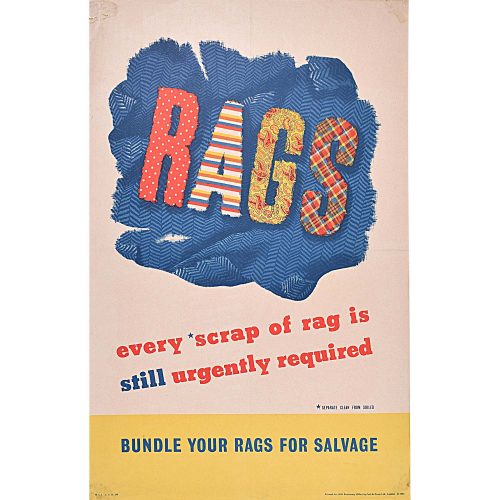
Anonymous
Rags Every bit of rag still urgently required
WW2 British Home Front Poster 75x49cm Lithograph in four colours If you are interested email info@manningfineart.co.uk or call us on 07929 749056. Condition: Good. -
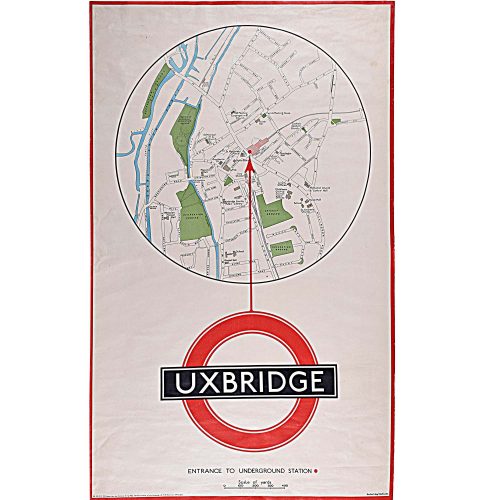
Uxbridge Station Poster c.1930 Printed by HMSO
Lithograph 100x62cm This four coloured lithograph was printed in extremely limited numbers for London Transport by HMSO. These maps detailed station entrances and were placed along the underground network to inform commuters exactly where they were in London. If you are interested email info@manningfineart.co.uk or call us on 07929 749056. Condition: Generally very good, slight bruising to the very edges in places, and a little touching in of the red border. -
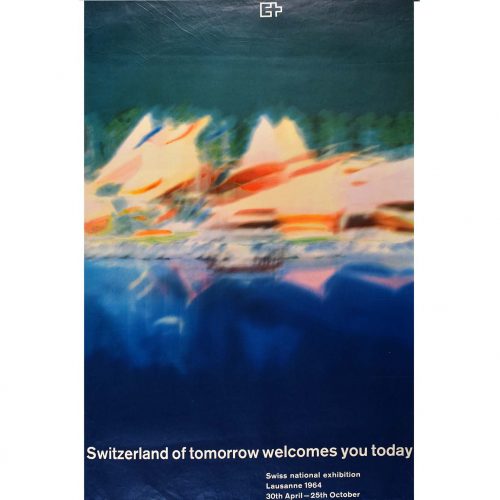
Switzerland of Tomorrow Welcomes You Today (1964)
Lithographic poster 152.4cm x 63.5 cm 1964 Original "Switzerland of Tomorrow" poster from the 1964 Swiss National Exhibition. As well as a brilliantly-designed futuristic poster printed in rich colours, it is a real piece of Swiss (and European) history. The poster is the English-language edition of a tourism-encouraging poster produced in several languages to welcome international visitors to an exhibition of Swiss innovation. Switzerland holds such an event four times per century, and the exhibitions often act as a portrait of contemporary culture, design, and politics. The 1964 National Exhibition in Lausanne offered a rather different representation of Switzerland from previous exhibitions. This was partly the result of its being held during one of the tensest periods of the Cold War; the attitudes of the Swiss were changing as the twentieth century progressed, as was the case for most Europeans, and the shadow of war had encouraged many citizens, businesses, and public bodies to reexamine their values. At "Expo 64", the nickname for that year's exhibition, the 'Gulliver Project' was introduced. The exhibition organisers made use of the character Gulliver (from Swift's 'Gulliver's Travels' to assess visitors' attitudes to daily life. A small questionnaire written by "Gulliver" was given to visitors, asking them questions about their societal attitudes, domestic lives, and work ethics, such as "Can you be a good Swiss and get up at 9am?". The theatre director Charles Apothéloz suggested having Gulliver ask these questions so as to make the questionnaire seem less serious, and to encourage people to answer truthfully. The questionnaire answers were compiled and analysed, but never published, as had been Apothéloz's initial intention. Charles Ascher discusses this at length in his 1965 article 'Gulliver in the Land of the Swiss'. If you are interested, please email info@manningfineart.co.uk or call us on 07929 749056. Condition: Good, pinholes to corners with some soft creases along bottom inch (would be hidden by mount). -

'Samivel' Paul Gayet-Tancrède (1907-1992) Les Pyrénées, France
Editions Mythra SA Chamonix Original Vintage Ski Poster 91x62cm With the ever-popular topic of skiing, Samivel here catches a chamois atop a Pyrenean hill, a mountain peak in the background. The chamois, a mountain goat-antelope, has hooked horns when fully grown, this one is likely a kid. Samivel was a writer, an artist, a photographer, an explorer and more. In 1948 he accompanied Paul Émile Victor on the first French Greenland expedition, making three documentary films in the process. His friends included Théodore Monod and Gilbert André - the latter the mayor of Bonneval-sur-Arc and one of the founders of the Vanoise National Park - and with them and others he spent his whole life aiming for the protection of the imperilled countryside. The graphic artist side of him had a life-long fascination with high mountains, and his illustrated books and series of posters of the French Alps have long been popular. Click here to see other posters by Samivel. If you are interested email info@manningfineart.co.uk or call us on 07929 749056. Condition: Generally very good, faint spotting towards bottom. -
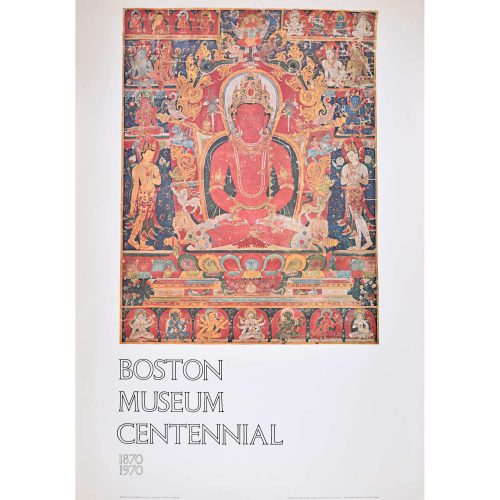
Anonymous Boston Museum Centennial 1870-1970
"Mandala of Eight Bodhisatlvas, Nepal 12th Century, Centennial Acquisition" 97x70cm Vintage poster 1970 If you are interested email info@manningfineart.co.uk or call us on 07929 749056. Condition: Good. -
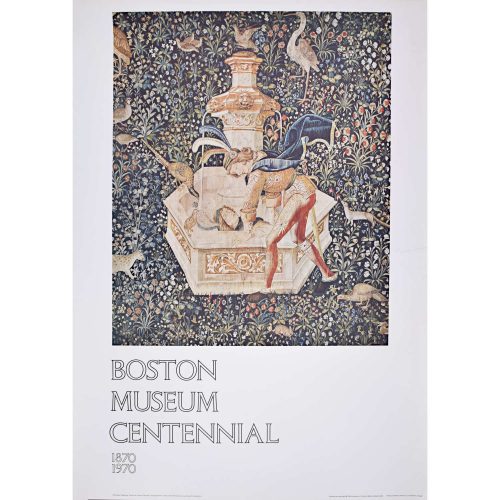
Anonymous Boston Museum Centennial 1870-1970
"Narcissus Tapestry, French or Franco-Flemish, Late 15th or 16th Century, Centennial Acquisition" 97x70cm Vintage poster 1970 If you are interested email info@manningfineart.co.uk or call us on 07929 749056. Condition: Good. Two repaired edge tears to right margin, not into image, one 3" long, other shorter; one repaired short tear to left. -
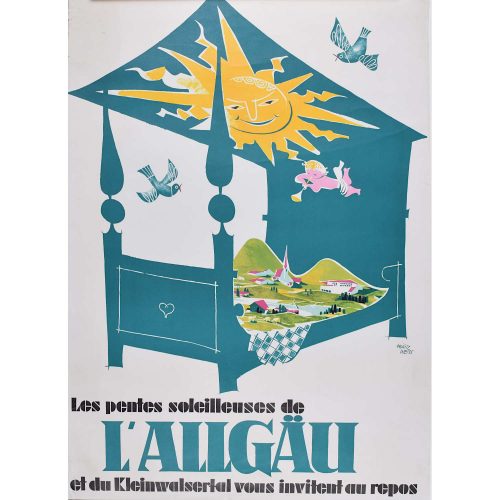
Franz Weiss (1903-1982) German/American L'Allgäu
Original Vintage poster/Affiche francaise 84x59cm American-German illustrator and graphic designer, Weiss has captured this poster in an amusing and charming way. If you are interested email info@manningfineart.co.uk or call us on 07929 749056. Condition: Good. Few short edge tears, little spotting to top left. -
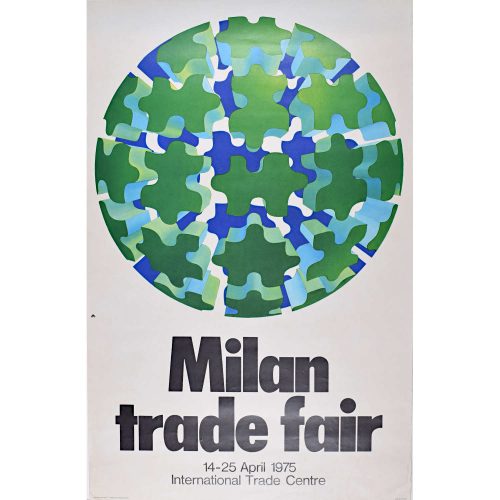
Anonymous Milan Trade Fair 1975
Original Vintage Poster 98x61cm A cool poster design from Italy, that home of mid-century modern design. We have been unable to trace any other copy of this poster; it is quite possibly the sole survivor. If you are interested email info@manningfineart.co.uk or call us on 07929 749056. Condition: Some gentle creasing, generally good condition. -
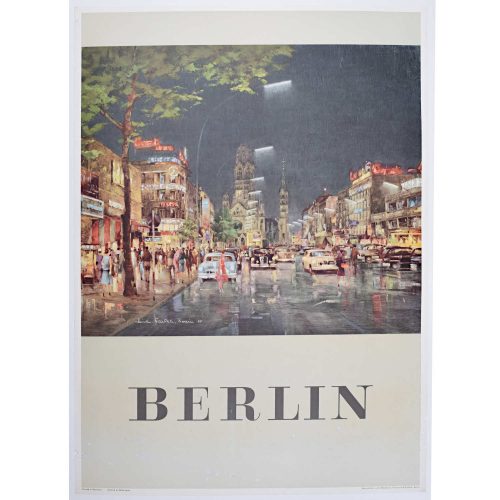
Anonymous
Berlin (1955)
Lithographic poster 84 x 61 cm Original Vintage Poster Kaiser Wilhelm Gedächtniskirche from Kurfürstendamm by Night A view of the 'Champs Elysee' of Berlin, the main shopping street in 1955. Although it was designed just ten years after the Second World War's end, when much of the city still bore the scars of devastating conflict, the poster still manages to evoke a pre-war idea of Berlin (especially seen through the glamorous lens of the postwar 1950s). Fashionable figures cross the street, the cars are the latest and brightest, and the humming city is reflected in the wet road. This poster was designed to be overprinted with the name of the local airline. If you are interested email info@manningfineart.co.uk or call us on 07929 749056. Condition: Good. Backed to linen. Small loss to bottom left corner in margin; a little white spotting to the 'Berlin' panel. -
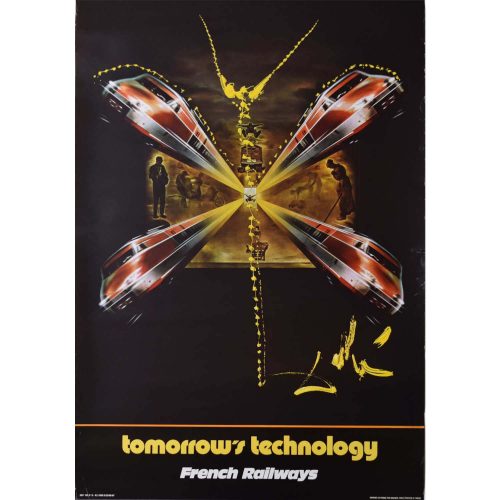
Salvador Dali Tomorrow's Technology
Original Poster for French Railways SNCF 60x37cm 1976 Signed in the plate Dali designed posters for SNCF for several years, a fruitful relationship. If you are interested email info@manningfineart.co.uk or call us on 07929 749056. Condition: Generally very good. -
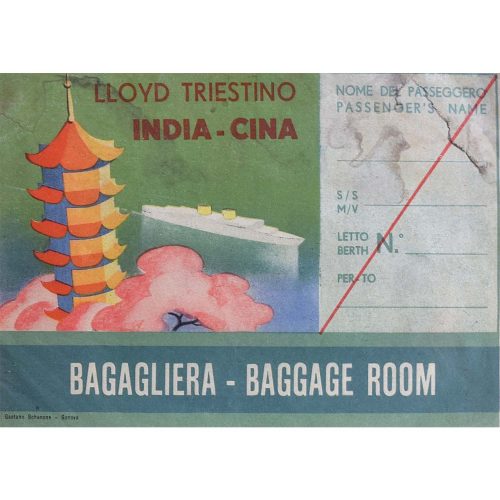
Lloyd
India to China Baggage Room Original Printed Luggage Label
Original Printed Luggage Label Mid 20th Century 12x16.5cm If you are interested email info@manningfineart.co.uk or call us on 07929 749056. Condition: Good, some faint watermarks -
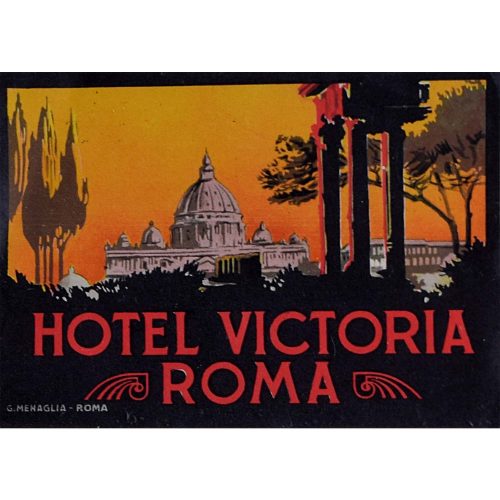
Anonymous
Hotel Victoria Roma
Original Printed Luggage Label Mid 20th Century 9x12.5cm If you are interested email info@manningfineart.co.uk or call us on 07929 749056. Condition: Good. -

Anonymous
Hotel Andréa Viipuri
Original Printed Luggage Label Mid 20th Century 10x10cm If you are interested email info@manningfineart.co.uk or call us on 07929 749056. Condition: Good. -
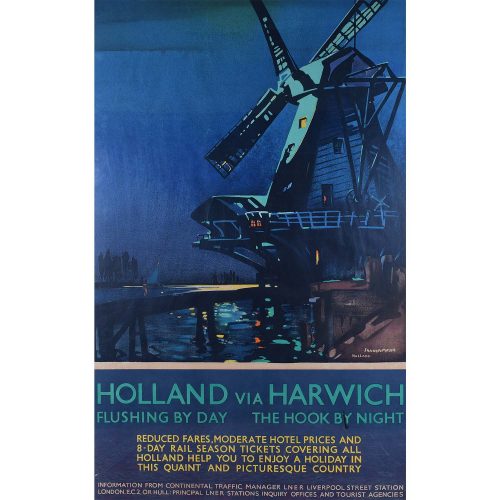
Anonymous
Holland via Harwich Original Vintage Poster
Lithograph 98.5x61cm 102x64cm including frame If you are interested email info@manningfineart.co.uk or call us on 07929 749056. Condition: Generally good, slight water mark in upper left corner. -
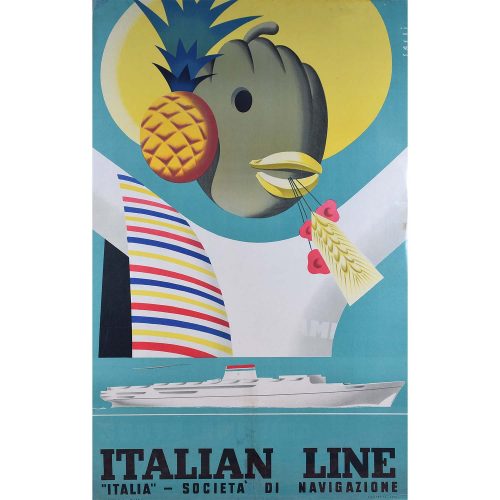
Sassi
Italian Line Societa di Navigatione Italia
Original Vintage Poster 97.5x61cm c.1950s A wonderful example of Italian surreal poster artwork, with a fish made from fruit and vegetables and a very sleek modern ship beneath. If you are interested email info@manningfineart.co.uk or call us on 07929 749056. Condition: Mounted to board, some areas of repair as visible in image towards bottom, overall good. -
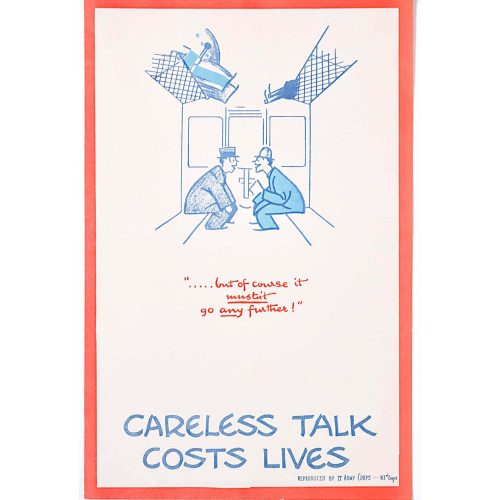
Cyril Kenneth Bird ‘Fougasse’ (British, 1887-1965) Careless Talk Costs Lives V
Lithographic poster c.1940 32 x 20 cm (12.5 x 8 in) Reprinted by the IV Army Corps by the 103rd Engineers Lacking the normal Fougasse edition, the IV Army Corps commissioned their Engineers - the 103rd Engineers - to produce their own edition. Indescribably rare, one of the ones in this series is inscribed 'To Al, with sincerest regards Warren C Guggenheim'. The cartoonist Fougasse, was a British cartoonist who was art editor of Punch 1937-1949, and subsequently editor until 1953. He is best known for his ‘Careless Talk Costs Lives’ series of posters, and the other posters both for the Ministry of Information, London Underground and others. The Ministry of Information’s wartime poster campaign was soon regarded as dull and uninspiring on account of its hectoring messages such as ‘Keep Calm and Carry On.’ There were posters telling the population how to conduct virtually every minute of their daily lives – for instance by saving old clothes for rags, turning off the lights, saving food, digging for victory, or watching out for spies. With this instruction overload the population ceased paying attention to the posters, so Fougasse offered his services to the Ministry of Information unpaid, with a view to bringing a touch of humour to serious messages. An amusing picture and a pithy caption helped to get the message across to the reader. His distinctive style, with the red border, was adopted by other Ministry artists. If you are interested email info@manningfineart.co.uk or call us on 07929 749056. Condition: Generally very good, a few very soft creases as normal. -
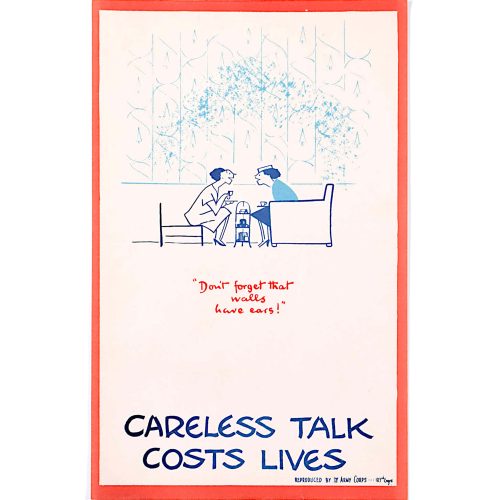
Cyril Kenneth Bird ‘Fougasse’ (British, 1887-1965) Careless Talk Costs Lives IV
Lithographic poster c.1940 32 x 20 cm (12.5 x 8 in) Reprinted by the IV Army Corps by the 103rd Engineers Lacking the normal Fougasse edition, the IV Army Corps commissioned their Engineers - the 103rd Engineers - to produce their own edition. Indescribably rare, one of the ones in this series is inscribed 'To Al, with sincerest regards Warren C Guggenheim'. The cartoonist Fougasse, was a British cartoonist who was art editor of Punch 1937-1949, and subsequently editor until 1953. He is best known for his ‘Careless Talk Costs Lives’ series of posters, and the other posters both for the Ministry of Information, London Underground and others. The Ministry of Information’s wartime poster campaign was soon regarded as dull and uninspiring on account of its hectoring messages such as ‘Keep Calm and Carry On.’ There were posters telling the population how to conduct virtually every minute of their daily lives – for instance by saving old clothes for rags, turning off the lights, saving food, digging for victory, or watching out for spies. With this instruction overload the population ceased paying attention to the posters, so Fougasse offered his services to the Ministry of Information unpaid, with a view to bringing a touch of humour to serious messages. An amusing picture and a pithy caption helped to get the message across to the reader. His distinctive style, with the red border, was adopted by other Ministry artists. If you are interested email info@manningfineart.co.uk or call us on 07929 749056. Condition: Generally very good, a few very soft creases as normal. -
Out of stock
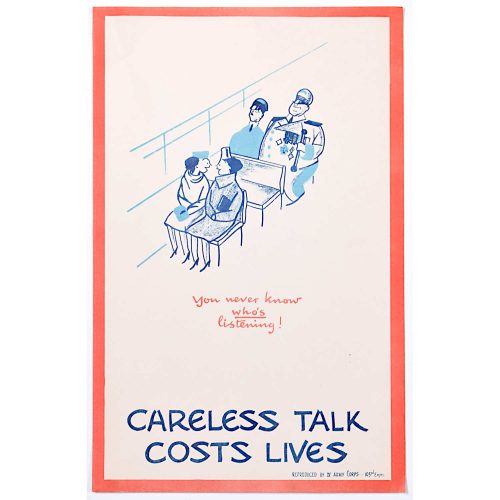
Cyril Kenneth Bird ‘Fougasse’ (British, 1887-1965) Careless Talk Costs Lives III
Lithographic poster c.1940 32 x 20 cm (12.5 x 8 in) Reprinted by the IV Army Corps by the 103rd Engineers Lacking the normal Fougasse edition, the IV Army Corps commissioned their Engineers - the 103rd Engineers - to produce their own edition. Indescribably rare, one of the ones in this series is inscribed 'To Al, with sincerest regards Warren C Guggenheim'. The cartoonist Fougasse, was a British cartoonist who was art editor of Punch 1937-1949, and subsequently editor until 1953. He is best known for his ‘Careless Talk Costs Lives’ series of posters, and the other posters both for the Ministry of Information, London Underground and others. The Ministry of Information’s wartime poster campaign was soon regarded as dull and uninspiring on account of its hectoring messages such as ‘Keep Calm and Carry On.’ There were posters telling the population how to conduct virtually every minute of their daily lives – for instance by saving old clothes for rags, turning off the lights, saving food, digging for victory, or watching out for spies. With this instruction overload the population ceased paying attention to the posters, so Fougasse offered his services to the Ministry of Information unpaid, with a view to bringing a touch of humour to serious messages. An amusing picture and a pithy caption helped to get the message across to the reader. His distinctive style, with the red border, was adopted by other Ministry artists. If you are interested email info@manningfineart.co.uk or call us on 07929 749056. Condition: Generally very good, a few very soft creases as normal. -
Out of stock
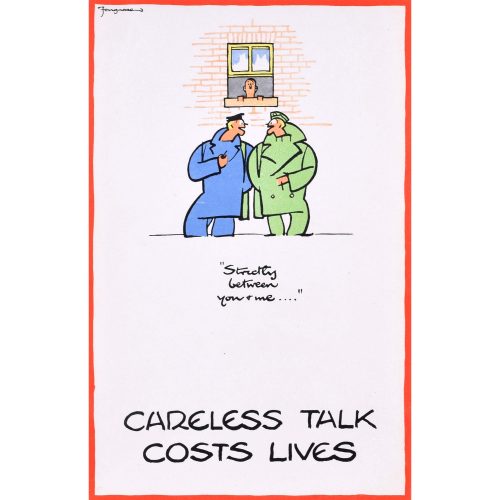
Cyril Kenneth Bird ‘Fougasse’ (British, 1887-1965) Careless Talk Costs Lives
Lithographic poster c.1940 32 x 20 cm (12.5 x 8 in) The cartoonist Fougasse, was a British cartoonist who was art editor of Punch 1937-1949, and subsequently editor until 1953. He is best known for his ‘Careless Talk Costs Lives’ series of posters, and the other posters both for the Ministry of Information, London Underground and others. The Ministry of Information’s wartime poster campaign was soon regarded as dull and uninspiring on account of its hectoring messages such as ‘Keep Calm and Carry On.’ There were posters telling the population how to conduct virtually every minute of their daily lives – for instance by saving old clothes for rags, turning off the lights, saving food, digging for victory, or watching out for spies. With this instruction overload the population ceased paying attention to the posters, so Fougasse offered his services to the Ministry of Information unpaid, with a view to bringing a touch of humour to serious messages. An amusing picture and a pithy caption helped to get the message across to the reader. His distinctive style, with the red border, was adopted by other Ministry artists. If you are interested email info@manningfineart.co.uk or call us on 07929 749056. Condition: Excellent. -
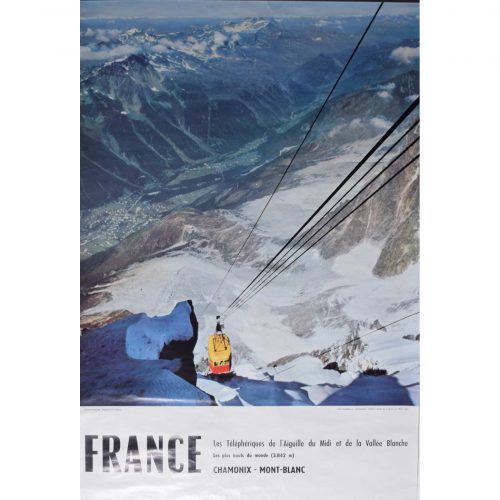
Télépheriques de l'Aiguille du Midi et de la Vallée Blanche Chamonix Mont Blanc
Original vintage poster 98x63cm Condition: Good, small loss to top-right corner approx 1cm x 1cm; some creases/very short tears to edges, and a few light creases to poster. Will look great once framed with a mount to hide the edge deficiencies. -
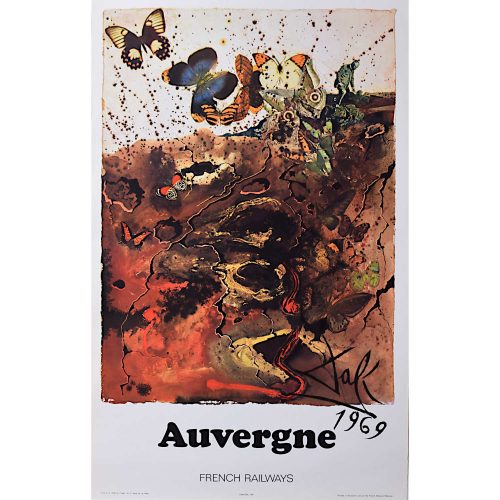
Salvador Dali (1904-1989) Auvergne
Original Poster for French Railways SNCF 100x60cm Printed by Draeger Printed in France for and by the French National Railways, 1970 Signed and dated in the plate 1969 From the Butterfly series. Condition: Generally excellent condition; slight age toning to edges of poster. -
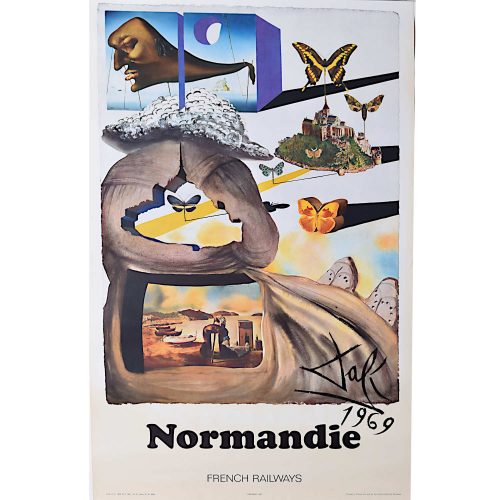
Salvador Dali (1904-1989) Normandy - Normandie
Original Poster for French Railways SNCF 100x60cm Printed by Draeger Printed in France for and by the French National Railways, 1970 Signed and dated in the plate 1969 From the Butterfly series. If you are interested email info@manningfineart.co.uk or call us on 07929 749056. Condition: Generally excellent condition; slight age toning to edges of poster. -
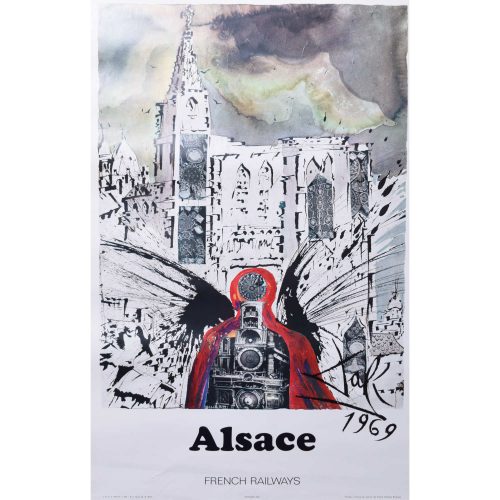
Salvador Dali (1904-1989) Alsace
Original Poster for French Railways SNCF 100x60cm Printed by Draeger Printed in France for and by the French National Railways, 1970 Signed and dated in the plate 1969 If you are interested email info@manningfineart.co.uk or call us on 07929 749056. Condition: Generally excellent condition; slight age toning to edges of poster. -
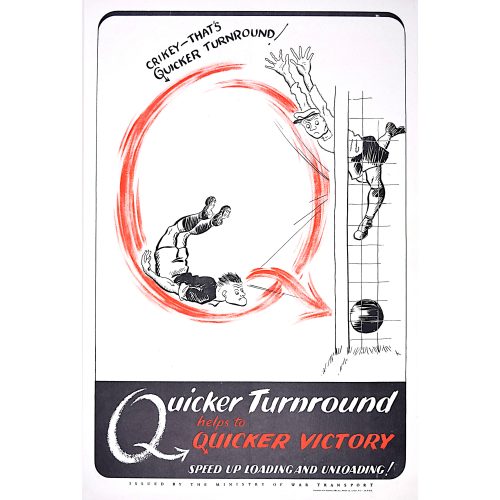
Ministry of War Transport Quicker Turnaround Helps to Quicker Victory - Football
Original vintage poster c. 1940 30x20" Printed by H M Stationery Office by J Weiner Ltd London WC1 Provenance, the Bendell Bayley studio. During the war, every aspect of life had its own Government influence. Here transport of war materiel is being managed and faster re-loading of transport is encouraged to improve efficiency. Condition: Good. Backed to linen. If you are interested email info@manningfineart.co.uk or call us on 07929 749056. -
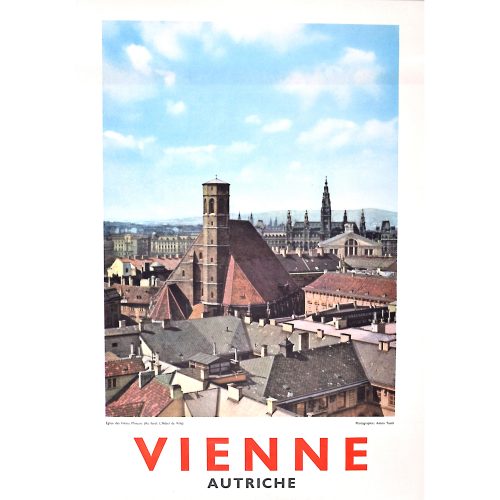
Anton Tusch (photographer) Eglise des Freres Mineurs, Vienna, Austria / Osterreich
Original poster c. 1950s 61x43cm If you are interested email info@manningfineart.co.uk or call us on 07929 749056. Condition: Generally very good. -
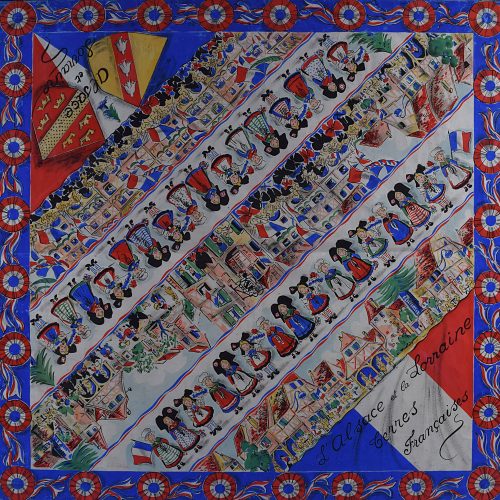
Design for Bianchi Ferier, Lyon for a silk scarf 5 March 1945
Gouache, pen and ink 78cm x 76cm Provenance: The Bianchi Ferrier archive sale at Christies On 9 February 1945 the 'Colmar Pocket' was finally cleared of Germans - a process that had started in November 1944 - and the province of Alsace changed hands between France and Germany for the fourth time in 75 years. Happily in the succeeding 75 years Alsace has not changed ownership. If you are interested email info@manningfineart.co.uk or call us on 07929 749056. Condition: Good. -
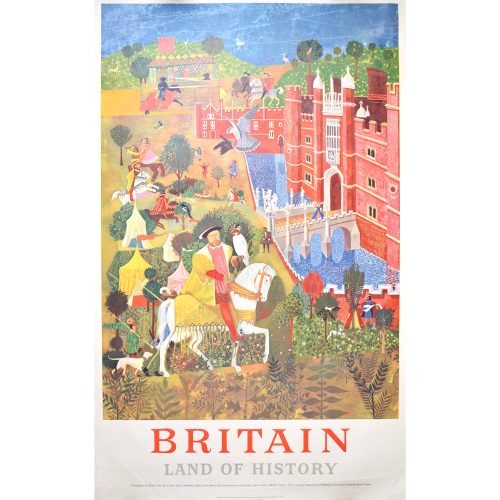
Britain Land of History Original Vintage Poster c. 1960
Published by the British Travel and Holidays Association and printed in Great Britain by Harrison and Sons Ltd 59/60.14 'Throughout the British Isles can be seen many interesting castles, royal palaces and country houses which have played a part in Britain's history. This is an artist's impression of Hampton Court Palace beside the River Thames.' If you are interested email info@manningfineart.co.uk or call us on 07929 749056. Condition: Generally good condition, a few very short repaired edge tears and the odd marginal crease. Mounted and framed the edge tears will not be visible. -
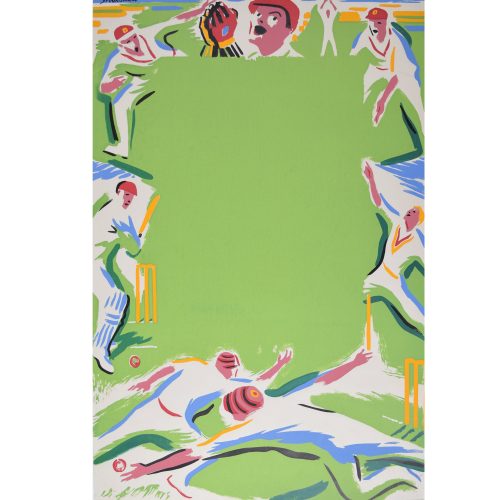
Percy Drake Brookshaw (1907-1993) Cricket
Original coach poster Lithograph c. 1950s 76x50cm A poster for advertising details of coaches to cricket matches such as The Ashes or other Test Matches. Brookshaw was born in Southwark, in London, and educated at the Central School of Arts and Crafts. He was a particularly accomplished lithographer, skilled also as a painter in both oil and watercolour. Identifying the former talent, F Gregory Brown - the poster and textile designer - encouraged him to become an illustrator and poster designer. Producing posters for London Transport and Shell, inter alia, between 1928 and 1958, many of his posters depict sporting events. His two posters for the annual University Boat Race are well known and highly sought after, and his wonderful posters often evoke a feeling of movement, whether rowers straining on their oars, or horses or greyhounds racing. If you are interested email info@manningfineart.co.uk or call us on 07929 749056. Conditon: Generally very good, a few short edge tears and soft creases, see photograph. -
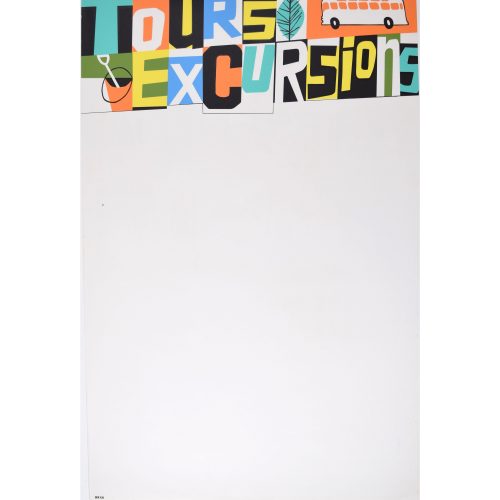
Anonymous Tours and Excursions
Original Coach Poster 75x50cm Cool and crazy mid-century lettering. Poster with area for completion with details of a coach tour. If you are interested email info@manningfineart.co.uk or call us on 07929 749056. Condition: Excellent. -
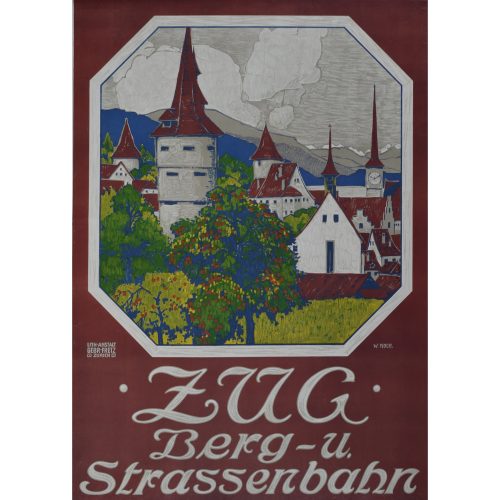
Walther Koch (1875-1915) Zug Berg und Strassenbahn
Original lithographic poster (1914) 40x30" Printed in Zurich by Anstalt Gebr Fretz If you are interested email info@manningfineart.co.uk or call us on 07929 749056. Condition: Excellent. -
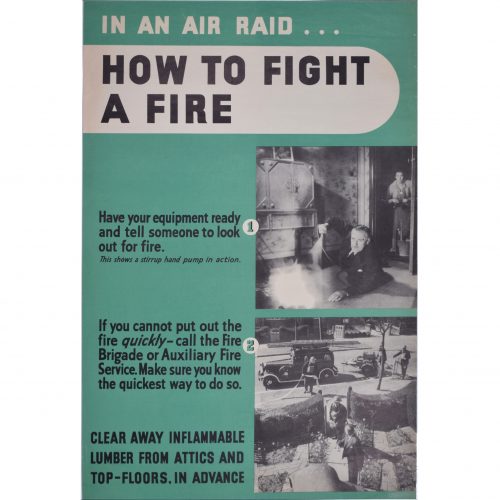
In an Air Raid... How to fight a fire World War 2 Vintage Poster
30x20" [HMSO, London] nd. np. A householder, dressed in a tie, is shown spraying water onto a fire, as his wife pumps water out of a bucket using a stirrup hand pump. Instructions are given to call the Fire Brigade if the fire cannot be extinguished. Householders are warned to clear away inflammable lumber from attics and top-floors, in advance. If you are interested email info@manningfineart.co.uk or call us on 07929 749056. Condition: Generally excellent, slight edge wear as usual. -
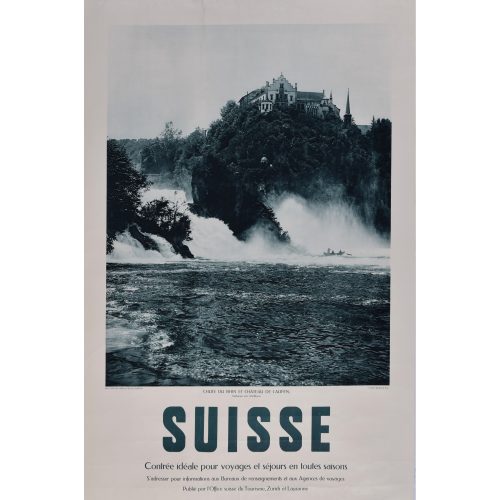
Suisse Chutes du Rhin
Original lithographic poster (1925) 40x25" If you are interested email info@manningfineart.co.uk or call us on 07929 749056. Condition: Generally good, a little edge wear. -
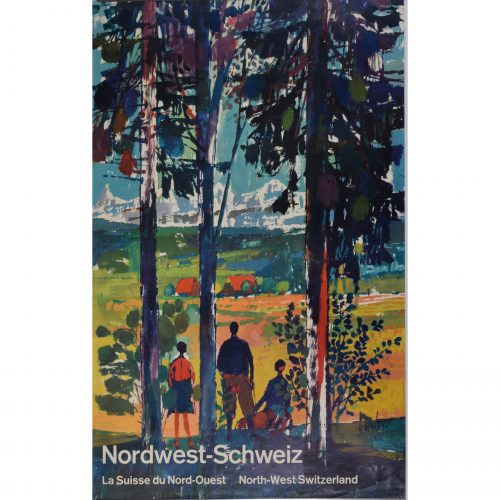
Hugo Wetli (1916-1972) Nordwest-Schweiz North-West Switzerland La Suisse du Nord-Ouest
Original Poster c. 1960s If you are interested email info@manningfineart.co.uk or call us on 07929 749056. Condition: Excellent. -

Hugo Wetli (1916-1972) Ticino - Come and Paint Ticino Contest for your holidays 1964
Original Poster 1964 If you are interested email info@manningfineart.co.uk or call us on 07929 749056. Condition: Excellent. -
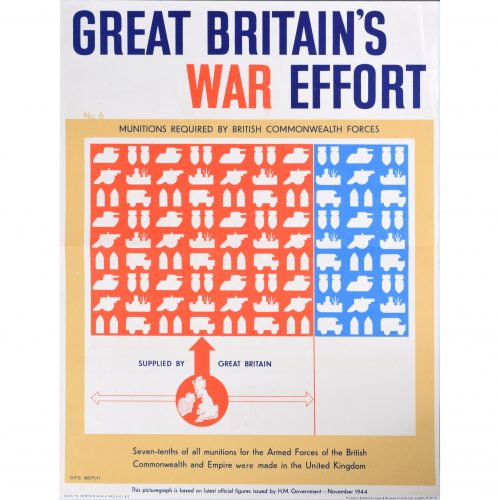
Printed by Lowe & Brydone Printers (1944)
Great Britain's War Effort No. 6 (Munitions)
50x37cm "Seven-tenths of all munitions for the Armed Forces of the British Commonwealth and Empire were made in the United Kingdom. This picturegraph is based on latest official figures issued by HM Government November 1944." The population of the Empire had to be persuaded that Britain was pulling her weight in World War 2. Bu this poster and others similar could the message be put across. The fine stylised tanks, bombs, ships, guns and other vehicles are stacked up on the left-hand side showing the British contribution. If you are interested email info@manningfineart.co.uk or call us on 07929 749056. Condition: Folds as issued, otherwise generally excellent. -
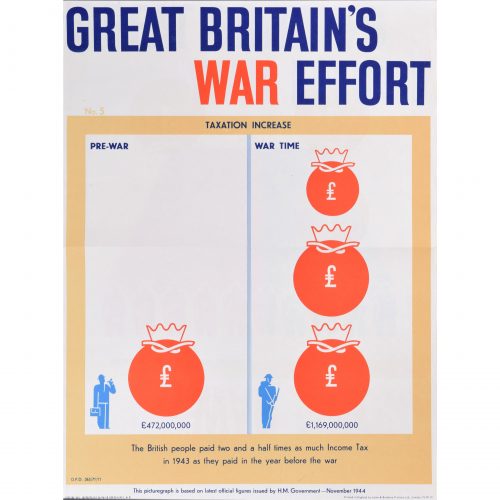
Printed by Lowe & Brydone Printers (1944)
Great Britain's War Effort No. 5 (Taxation)
50x37cm "The British people paid two and a half times as much Income Tax in 1943 as they paid in the year before the war. This picturegraph is based on latest official figures issued by HM Government November 1944." Pre-war taxation: £472,000,000 War-time £1,169,000,000 The population of the Empire had to be persuaded that Britain was pulling her weight in World War 2. By this poster and others similar could the message be put across. If you are interested email info@manningfineart.co.uk or call us on 07929 749056. Condition: Folds as issued, otherwise generally excellent. -
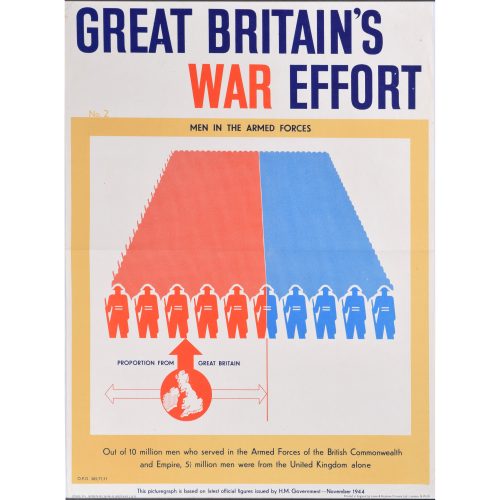
Printed by Lowe & Brydone Printers (1944)
Great Britain's War Effort No. 2 (Men in the armed forces)
50x37cm "Of the ten million men who served in the Commonwealth's Armed Forces five-and-a-half million men were from the United Kingdom alone. This picturegraph is based on latest official figures issued by HM Government November 1944." The population of the Empire had to be persuaded that Britain was pulling her weight in World War 2. By this poster and others similar could the message be put across. If you are interested email info@manningfineart.co.uk or call us on 07929 749056. Condition: Folds as issued, otherwise generally excellent. -
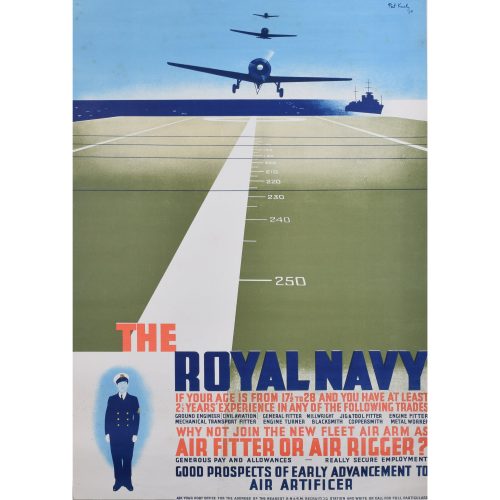
Pat Keely (d. 1970) The Royal Navy
75x51cm Original lithographic poster 1939 Printed for HMSO by Vincent Brooks, Day & Son Ltd, London If your age is from 17 1/2 to 28 and you have at least 2 1/2 years' experience in any of the following trades: Ground Engineer (Civil Aviation) General Fitter Millwright Jig & Tool Fitter etc. Why not join the new Fleet Air Arm as Air Fitter or Air Rigger Generous Pay and Allowances - Really Secure Employment Good Prospects of Early Advancement to Air Artificer Little is known of the life of the rather private Pat Keely, a prolific and excellent designer of posters. He designed the World Scout Jamboree 4d stamp in 1957 and produced many posters for the British Government. In this excellent poster three aeroplanes are seen landing on the deck of an aircraft carrier; although somewhat stylised they are likely to be the Blackburn Skua. If you are interested email info@manningfineart.co.uk or call us on 07929 749056. Condition: Generally very good. -
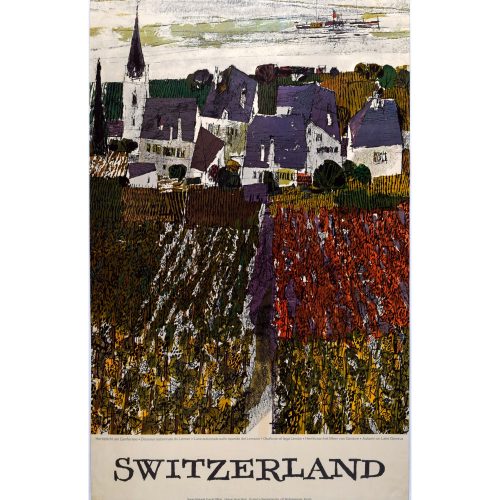
Hugo Wetli (1916-1972) Autumn on Lake Geneva Herbst am Genfersee Douceur automnale du Léman
Original Poster c. 1960s 40x25" If you are interested email info@manningfineart.co.uk or call us on 07929 749056. Condition: Pinholes to corners, some soft creases, not backed, generally good. -
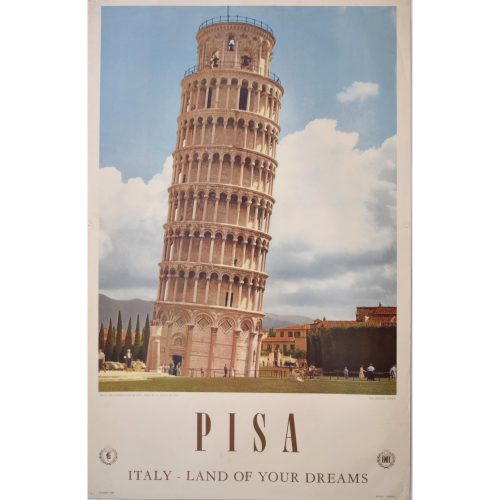
Ente Nazionale Italiano per il Turismo (The Italian Government Tourist Board)
PISA - ITALY - LAND OF YOUR DREAMS
Lithographic poster 101 x 63.5 cm If you are interested, please email info@manningfineart.co.uk or call us on 07929 749056. Condition: Good. Pin-holes to corners; not backed. -

Lance Cottermole A Map of Northumberland & Durham, UK
1949 Lithographic poster Published for Railway Executive 102x63cm If you are interested email info@manningfineart.co.uk or call us on 07929 749056. Condition: Good. Backed to linen, repaired tear, presents very well. -
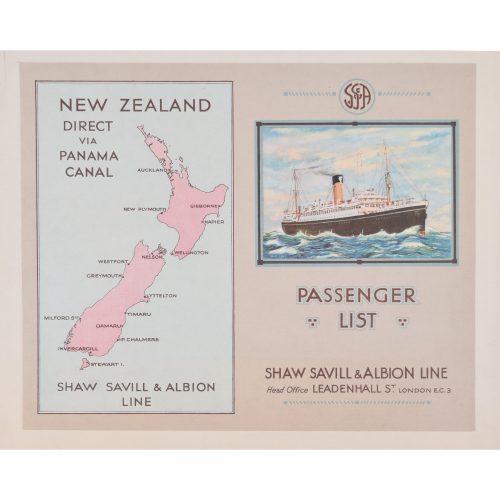
A E Agar (artist) Original passenger list brochure for Shaw Savill Albion Line, c. 1940s or 1950s.
24x34cm (approx) Provenance: the artist's estate As new, unissued printer's proof. Could be trimmed to the brochure size if desired. Fine image of ocean liner to front cover, map - via Panama Canal - to back cover. From the great age of Ocean Liners. If you are interested email info@manningfineart.co.uk or call us on 07929 749056. Condition: Excellent. -

Claude Harrison Shell Guide to Westmoreland
Original poster for Shell Oil c. 1960s 76x51cm Shell commissioned a series of posters to go with their County Guide books, and they commissioned paintings by the leading artists of the day. Claude Harrison studied at Preston College of Art (1939-1941) and Liverpool College of Art (1941-2) after which he enlisted in the RAF for five years. On his return, he continued studies at Royal College of Art (1947-50). Harrison’s work consisted of murals, portraits, conversation pieces and mystical figure compositions - which are seen here in the Westmoreland poster. He was a member of the Royal Academy and his work has regularly been exhibited in the annual summer exhibition. If you are interested email info@manningfineart.co.uk or call us on 07929 749056. Condition: Fair. Short edge tears which are hidden by mount/mat; some age toning. Metal hanger removed to allow matting. See photograph for more information -
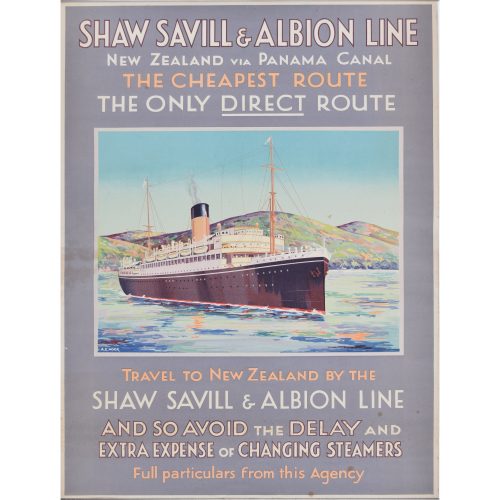
A E Agar (artist) Original advertising poster for Shaw Savill Albion Line, c. 1940s or 1950s.
51x38cm Provenance: the artist's estate Fine image of ocean liner. From the great age of Ocean Liners. If you are interested email info@manningfineart.co.uk or call us on 07929 749056. Condition: Good. -
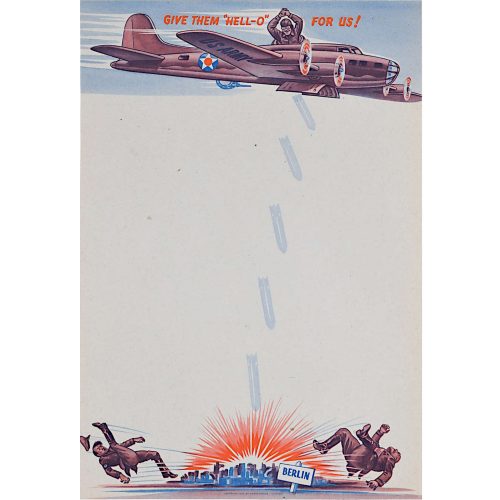
Porto-Service, Chicago Give them "Hell-o from us!"
Lithograph 26.5x18cm 1942 What better writing paper to send to a serving serviceman than one encouraging him to fight. Porto-Service of Chicago published a series of illustrated writing resources for sweethearts and friends to write to their brave servicemen, in this case in a four-engined bomber over Berlin. Lavishly produced and printed, the Americans brought some much-needed colour and glamour to dull war-torn Britain. If you are interested email info@manningfineart.co.uk or call us on 07929 749056. Condition: Very good. -
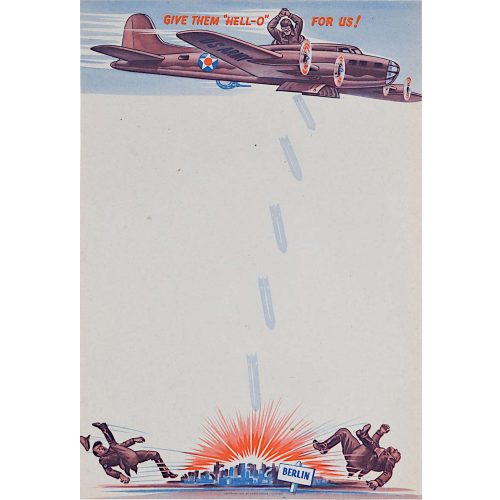
Porto-Service, Chicago Keep 'em Running Right off the Map!
Lithograph 26.5x18cm 1942 What better writing paper to send to a serving serviceman than that encouraging him to fight. Porto-Service of Chicago published a series of illustrated writing resources for sweethearts and friends to write to their brave servicemen, in this case teasing the three Axis dictators. Lavishly produced and printed, the Americans brought some much-needed colour and glamour to dull war-torn Britain. If you are interested email info@manningfineart.co.uk or call us on 07929 749056. Condition: Very good. -
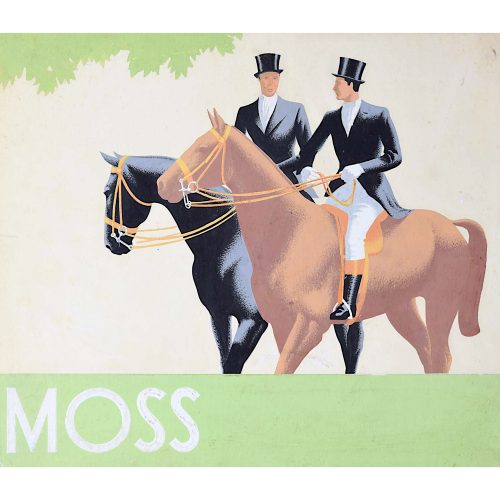
Anonymous Moss Gouache original design for poster
30x33cm c. 1930s Sadly the artist is unknown, but this rather good example of commercial artwork cleverly places the images of two impeccably dressed horse riders upon tremendously handsome horses. If you are interested email info@manningfineart.co.uk or call us on 07929 749056. Condition: Generally good condition, a few old losses as may be seen in picture. -

Hans Schleger 'Zero' (1898-1976) London Transport Coach Stop Request Poster
Screenprint poster c. 1970 16x18 cm Printed for London Transport These posters were designed to be used as temporary stops when the usual stop required amendment for instance owing to road works or similar events. Printed on paper they were designed to be posted up at the alternative site, possibly over a different sort of stop (bus stop, coach stop, request stop, etc.). Working with Edward Johnson's special typeface created for London Transport, Hans Schleger - or Zero as he signed himself - adopted the famous roundel used by London Underground for use at Bus Stops. Born in Germany, Schleger was an influential graphic designer. After serving during the First World War, he studied at the Berlin Kunstgewerbeschule, being taught by Emil Orlik. The same year Walter Gropius founded the Bauhaus at Weimar and Schleger learned the same principles of breaking down the barriers between architecture, design, fine art and craft. A firm believer in the Bauhaus principles of simplicity in design and reduction to essentials, these may be seen in the clean lines of the roundel. In 1924 he moved to New York, applying Modernism to American advertising, and then returned to Berlin in 1929 working for the British advertising agency Crawfords, where he met Edward McKnight Kauffer who introduced him to Jack Beddington the head of advertising at Shell Mex BP. Following the rise of Hitler he emigrated to London where he produced a series of posters for Shell Mex. During World War 2 he worked for the British Government. In 1950 he taught at the Chicago Institute of Design which had been founded by Moholy-Nagy, thus bringing him back to his Bauhaus origins. Subsequently he designed the trademarks of John Lewis Partnership, Penguin, Deutsche Bank and the Edinburgh Festival. If you are interested email info@manningfineart.co.uk or call us on 07929 749056. Condition: In unissued condition. Mounted. -

Hans Schleger 'Zero' (1898-1976) London Transport Bus Stop Poster
Screenprint poster c. 1970 16x17.8 cm Printed for London Transport These posters were designed to be used as temporary stops when the usual stop required amendment for instance owing to road works or similar events. Printed on paper they were designed to be posted up at the alternative site, possibly over a different sort of stop (bus stop, coach stop, request stop, etc.). Working with Edward Johnson's special typeface created for London Transport, Hans Schleger - or Zero as he signed himself - adopted the famous roundel used by London Underground for use at Bus Stops. Born in Germany, Schleger was an influential graphic designer. After serving during the First World War, he studied at the Berlin Kunstgewerbeschule, being taught by Emil Orlik. The same year Walter Gropius founded the Bauhaus at Weimar and Schleger learned the same principles of breaking down the barriers between architecture, design, fine art and craft. A firm believer in the Bauhaus principles of simplicity in design and reduction to essentials, these may be seen in the clean lines of the roundel. In 1924 he moved to New York, applying Modernism to American advertising, and then returned to Berlin in 1929 working for the British advertising agency Crawfords, where he met Edward McKnight Kauffer who introduced him to Jack Beddington the head of advertising at Shell Mex BP. Following the rise of Hitler he emigrated to London where he produced a series of posters for Shell Mex. During World War 2 he worked for the British Government. In 1950 he taught at the Chicago Institute of Design which had been founded by Moholy-Nagy, thus bringing him back to his Bauhaus origins. Subsequently he designed the trademarks of John Lewis Partnership, Penguin, Deutsche Bank and the Edinburgh Festival. If you are interested email info@manningfineart.co.uk or call us on 07929 749056. Condition: In unissued condition. Mounted. -
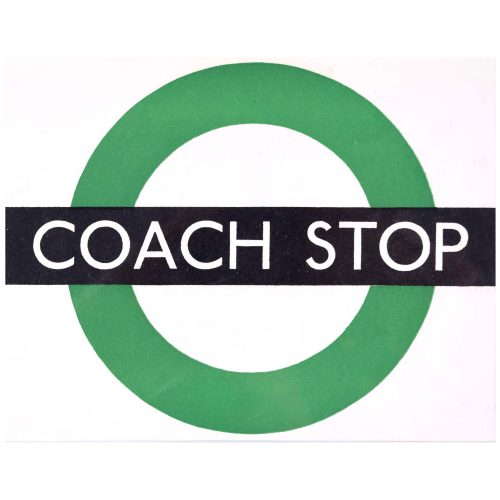
Hans Schleger 'Zero' (1898-1976) London Transport Coach Stop Poster
Screenprint poster c. 1970 16x20 cm Printed for London Transport These posters were designed to be used as temporary stops when the usual stop required amendment for instance owing to road works or similar events. Printed on paper they were designed to be posted up at the alternative site, possibly over a different sort of stop (bus stop, coach stop, request stop, etc.). Working with Edward Johnson's special typeface created for London Transport, Hans Schleger - or Zero as he signed himself - adopted the famous roundel used by London Underground for use at Bus Stops. Born in Germany, Schleger was an influential graphic designer. After serving during the First World War, he studied at the Berlin Kunstgewerbeschule, being taught by Emil Orlik. The same year Walter Gropius founded the Bauhaus at Weimar and Schleger learned the same principles of breaking down the barriers between architecture, design, fine art and craft. A firm believer in the Bauhaus principles of simplicity in design and reduction to essentials, these may be seen in the clean lines of the roundel. In 1924 he moved to New York, applying Modernism to American advertising, and then returned to Berlin in 1929 working for the British advertising agency Crawfords, where he met Edward McKnight Kauffer who introduced him to Jack Beddington the head of advertising at Shell Mex BP. Following the rise of Hitler he emigrated to London where he produced a series of posters for Shell Mex. During World War 2 he worked for the British Government. In 1950 he taught at the Chicago Institute of Design which had been founded by Moholy-Nagy, thus bringing him back to his Bauhaus origins. Subsequently he designed the trademarks of John Lewis Partnership, Penguin, Deutsche Bank and the Edinburgh Festival. If you are interested email info@manningfineart.co.uk or call us on 07929 749056. Condition: In unissued condition. Mounted. -
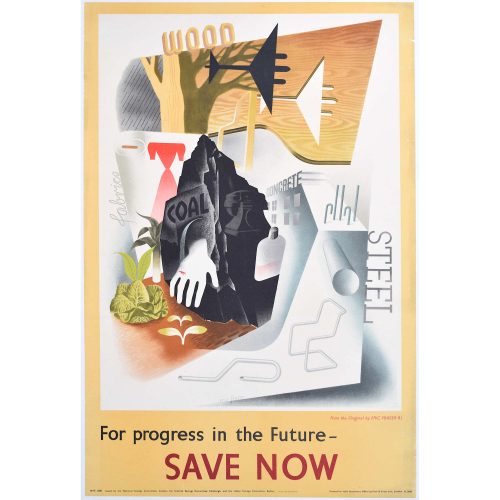
Eric Fraser For Progress in the Future Save Now
75x51cm Original Vintage Poster Issued by the National Savings Committee If you are interested email info@manningfineart.co.uk or call us on 07929 749056. Condition: Backed to linen, small edge tears to right side as visibile in image. -
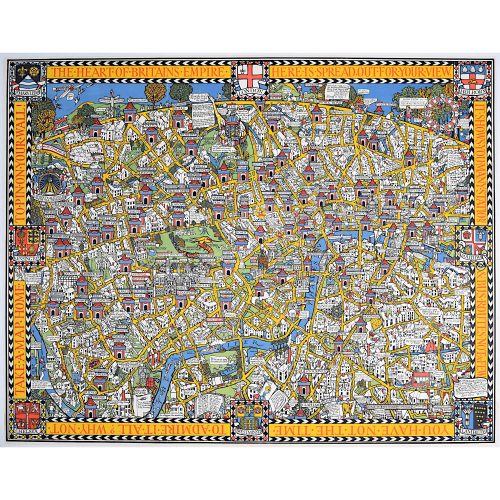
Macdonald (Max) Gill (1884-1947) Wonderground Map of London (c. 1924, after 1914 original edition)
Lithographic poster 75x94cm In the present work, in the top left-hand corner it reads 'On to Wembley' making reference to the British Empire Exhibition of 1924. Gill's original 1914 poster was hugely popular and reprinted with updates to feature topical events. Born in Brighton, Max Gill was the second son in a family of thirteen children; his elder brother was Eric Gill, the typographer and sculptor. Both Gills exhibited significant talent at a young age. Max Gill’s first map was made for a school map-drawing project following which he entered maps into competitions in boys’ magazines. In 1903 he moved to London as assistant to the ecclesiastical architects Sir Charles Nicholson and Hubert Corlette. By 1908 he had started his own architectural practice, but in 1909 Sir Edwin Lutyens commissioned Gill to paint a “wind dial” map for Nashdom, a large house in Buckinghamshire. The wind dial was set over the fireplace and attached to a weather vane on the roof, allowing the occupant to know the direction of the wind from the comfort of the house. He produced seven further wind dials including for Lutyens’s Lindisfarne Castle and for the Allhusen Room at Trinity College, Cambridge. Although he continued to practice as an architect, Frank Pick commissioned him to create seven pictorial maps for the Underground, the first being the famous 1913 ‘Wonderground Map of London Town.’ In 1917 he joined the Imperial War Graves Commission’s headstone design committee, designing the typeface and regimental badges. Gill’s memorials for the fallen in the First World War include for Balliol and Worcester Colleges and Christ Church in Oxford. During the 1920s and 30s Gill undertook many commercial commissions for advertising materials. The Empire Marketing Board and Shell-Mex as well as further maps for the Underground. He designed in 1922 the first diagrammatic map of the Underground which provided the foundation for Beck’s more famous map. By the 1930s his major works were murals. Those of the Arctic and Antarctic on the ceilings of the Scott Polar Research Institute in Cambridge are beautiful, but the most impressive is the map of the North Atlantic in the first-class dining room of the Queen Mary (maiden voyage: 1936, now moored at Long Beach, California). During the Second World War he created a series of propaganda posters for the Ministry of Information. -

Nat Harrison
Accidents Sometimes Happen... Work Carefully Avoid Scrap
Original poster c. 1943 Printed for HMSO by J Weiner Ltd, London for the Ministry of Aircraft Production Produced by the Bayly-Souster advertising agency, Fleet Street Provenance the estate of Ernest Bendell-Bayly The waste-not-want-not campaign of World War 2 in the UK had to tackle waste at all levels. Here workers in aircraft factories are encouraged to work carefully in order to avoid creating products that had to be scrapped. Not only were the raw materials scrapped, but also the valuable hours of workers' time involved. When Lord Beaverbrook commenced his term as Minister of Aircraft Production in May 1940 it was an industry beset with problems. Aircraft parts were produced in sufficient numbers, but assembly into flyable aircraft proved more challenging – the Castle Bromwich Spitfire factory had not produced a single completed aircraft by this point. Moreover the RAF central depots had large supplies of aircraft that had not been issued to squadrons. Once this was all brought under Beaverbrook’s control, aircraft production increased rapidly. During the Battle of Britain, the British production of fighter aircraft was two-and-a-half times that of Germany. Britain had 644 operable fighters at the start of July 1940 – when the Battle of Britain began – against the German 725. By the end of October 1940, when the German offensive finished, British fighter aircraft had – despite significant losses – increased to 732 whilst the Germans were left with just 275. To achieve this great productivity increase the Ministry was run on informal grounds; few notes were kept; staff members had few formal roles. Essential to the success were motivational posters in the aircraft factories. If you are interested email info@manningfineart.co.uk or call us on 07929 749056. -
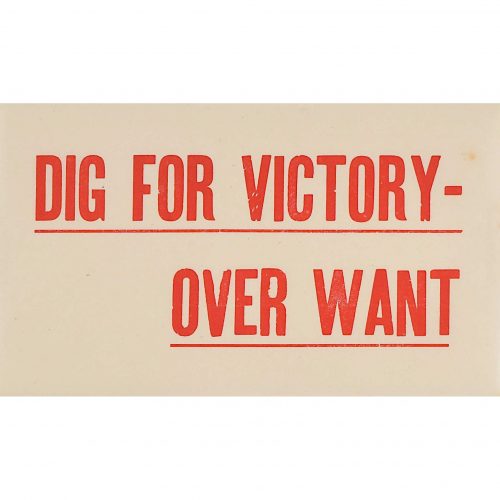
Dig for Victory over Want World War II public information
11x18cm for His Majesty's Stationery Office HMSO On gummed paper Printed on gummed paper, this was designed to be widely propagated, so that the public information message would not get lost. With food having to be shipped over the U-Boat infested Atlantic putting sailors' lives and ships at risk, every scrap of food that could be grown at home saved lives and allowed munitions to be transported instead. Therefore the Government started a large public information campaign to Dig for Victory - encouraging people to dig up their gardens and grow food. If you are interested email info@manningfineart.co.uk or call us on 07929 749056. -
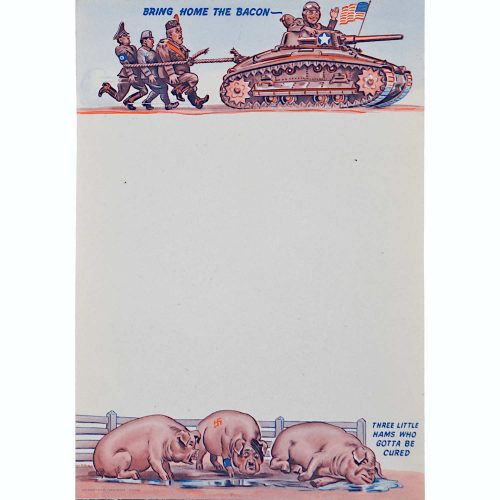
Porto-Service, Chicago Bring Home the Bacon - three little hams who gotta be cured!
Lithograph 26.5x18cm 1942 What better writing paper to send to a serving serviceman than that encouraging him to fight. Porto-Service of Chicago published a series of illustrated writing resources for sweethearts and friends to write to their brave servicemen, in this case teasing the three Axis dictators. Lavishly produced and printed, the Americans brought some much-needed colour and glamour to dull war-torn Britain. If you are interested email info@manningfineart.co.uk or call us on 07929 749056. -
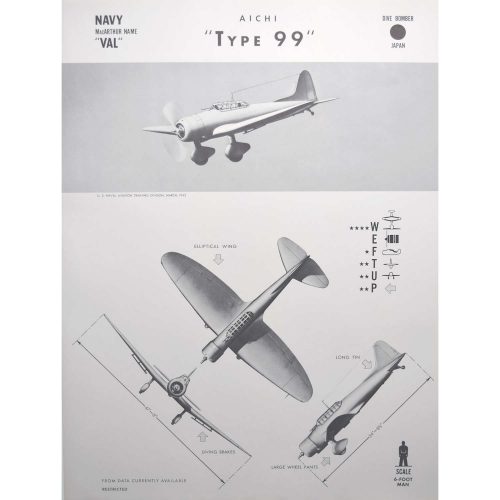
1942 MacArthur name "Val" Aichi "Type 99"
World War II Japanese dive bomber plane
Original aeroplane identification poster, 1942 63 x 47 cm A particularly unusual style of aeroplane identification poster, owing to the very arty images. Most such posters rely on very plain silhouettes, this series - and we have many in this series - have a much more arty approach to the task with shading and an interesting angle view. The Aichi D3A Type 99 Carrier Bomber (Allied reporting name "Val") was a World War II carrier-borne dive bomber. It was the primary dive bomber of the Imperial Japanese Navy (IJN) and was involved in almost all IJN actions, including the attack on Pearl Harbor. The Aichi D3A was the first Japanese aircraft to bomb American targets in the war, commencing with Pearl Harbor and U.S. bases in the Philippines, such as the Clark Air Force Base. They sank more Allied warships than any other Axis aircraft. If you'd like to know more, please email info@manningfineart.co.uk or call us on 07929 749056. -
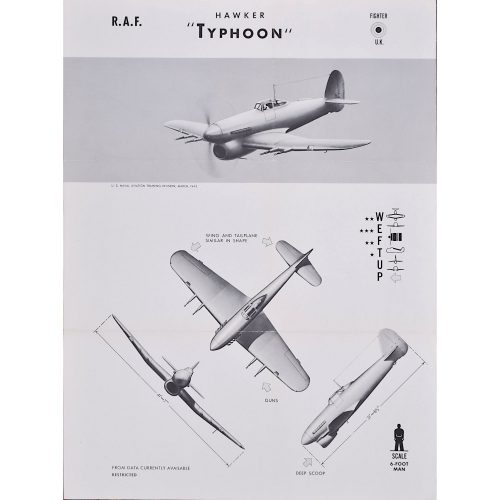
US Naval Aviation Training Division
RAF Hawker Typhoon World War 2 US airplane
Original aeroplane identification poster, 1942 63x47cm A particularly unusual style of aeroplane identification poster, owing to the very arty images. Most such posters rely on very plain silhouettes, this series - and we have several in this series (click here) - have a much more arty approach to the task with shading and an interesting angle view. The Typhoon is a single-seat fighter-bomber nicknamed the 'Tiffy'. Designed as a replacement for the Hawker Hurricane it never completely satisfied this expectation. However it was the only RAF fighter capable of catching the Fw 190 at low altitudes when the latter came into service in 1941. It became one of the most effective ground-attack aircraft of the Second World War. 3317 were produced and only one complete Typhoon still exists which belongs to the Royal Air Force Museum in Hendon. If you are interested email info@manningfineart.co.uk or call us on 07929 749056. -

US Naval Aviation Training Division
RAF Bristol Beaufighter World War 2 US airplane
Aeroplane identification poster, 1942 63 x 47 cm A particularly unusual style of aeroplane identification poster, owing to the very arty images. Most such posters rely on very plain silhouettes, this series - and we have several in this series (click here) - have a much more arty approach to the task with shading and an interesting angle view. The Beaufighter is a multi-role aircraft conceived originally as a heavy fighter variant of the Bristol Beaufort. As an effective night fighter it came into service during the Battle of Britain, having the space for radar it became a highly effective night fighter. The de Havilland Mosquito, being somewhat faster, took over in the latter part of 1942. The Beaufighter saw service in all theatres during World War II, serving through to the Greek civil war in 1946. 5,928 were built but no flying examples exist today, although The Fighter Collection at Duxford is currently restoring an aircraft (made from multiple aircraft). If you are interested, please email info@manningfineart.co.uk or call us on 07929 749056. -
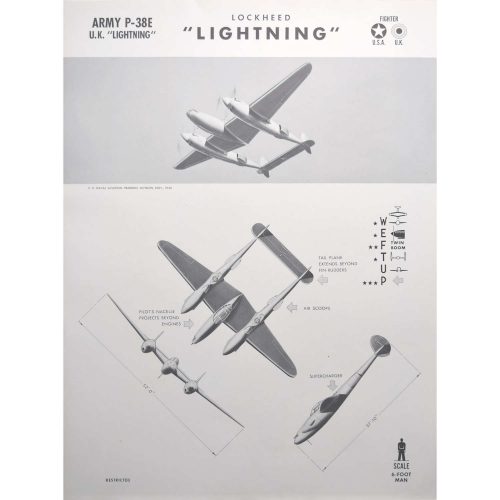
Army P-38E Lockheed "Lightning"
Aeroplane identification poster, published 1942 63 x 47 cm A particularly unusual style of aeroplane identification poster, owing to the very arty images. Most such posters rely on very plain silhouettes, this series - and we have several in this series; view them here - have a much more arty approach to the task with shading and an interesting angle view. The Lockheed P-38 Lightning was an American single-seated, twin piston-engined fighter aircraft that was used during World War II. The Lightning was originally designed as a bomber-interceptor and was never intended to be a fighter. Weight was kept to a minimum and it was far more advanced and faster than its U.S. counterparts, the Bell P-39 Airacobra and Curtiss P-40 Warhawk (original Airacobra and Warhawk posters from the same 1942 series are also available in our storefront). It caught the attention of the US Army Air Corps (USAAC) very quickly. The Lightning shot down more Japanese aeroplanes than any other fighter during World War II. When first introduced in 1939, the Lightning was able to fly a steady course at 413 mph (665 km/h), making it the fastest production aeroplane in the world. It remained one of the fastest climbers right up to the end of the WW II. Condition: generally very good. If you are interested, please email info@manningfineart.co.uk or call us on 07929 749056. -
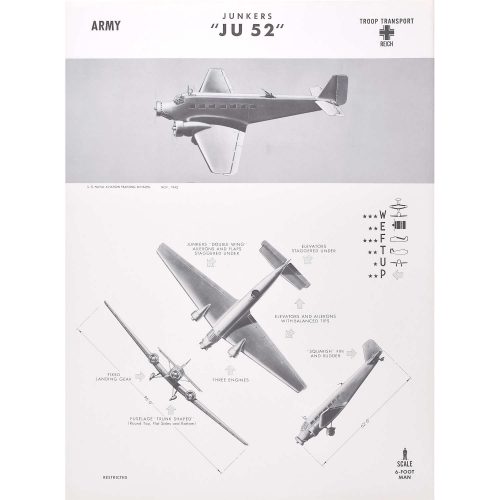
Junkers "JU 52"
Aeroplane identification poster, published 1942 63 x 47 cm A particularly unusual style of aeroplane identification poster, owing to the very arty images. Most such posters rely on very plain silhouettes, this series - and we have several in this series; view them here - have a much more arty approach to the task with shading and an interesting angle view. The Junkers Ju 52/3m (nicknamed Tante Ju ("Aunt Ju") and Iron Annie) was a transport aircraft that was designed and manufactured by German aviation company Junkers. Development of the Ju 52 commenced during 1930, headed by German aeronautical engineer Ernst Zindel. Its maiden flight was on 13 October 1930. Following the rise of Nazi Germany, thousands of Ju 52s were procured as a staple military transport of the nation. The Ju 52 was in production between 1931 and 1952. In a civilian role, it flew with over 12 airlines, including Swissair and Deutsche Luft Hansa, as both a passenger carrier and a freight hauler. In a military role, large numbers flew with the Luftwaffe, being deployed on virtually all fronts of the Second World War as a troop and cargo transport; it was also briefly used as a medium bomber. Additionally, the type was deployed by other nation''s militaries in conflicts such as the Spanish Civil War, the Chaco War, and the Portuguese Colonial War. During the postwar era, the Ju 52 had a lengthy service life with numerous military and civilian operators; large numbers were still in use by the 1980s. Even in the 21st century, several aircraft have remained operational, typically used for purposes such as heritage aviation displays and aerial sightseeing. Condition: generally very good. If you are interested, please email info@manningfineart.co.uk or call us on 07929 749056. -
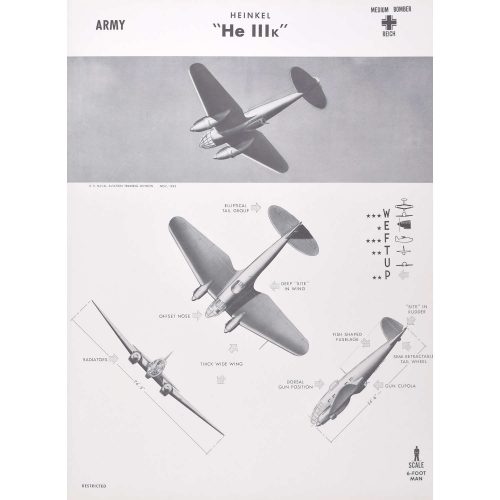
Heinkel "He 111K"
Aeroplane identification poster, published 1942 63 x 47 cm A particularly unusual style of aeroplane identification poster, owing to the very arty images. Most such posters rely on very plain silhouettes, this series - and we have several in this series; view them here - have a much more arty approach to the task with shading and an interesting angle view. The Heinkel He 111 was a German bomber aircraft designed by Siegfried and Walter Günter at Heinkel Flugzeugwerke in 1934. Through development it was described as a "wolf in sheep''s clothing"; due to restrictions placed on Germany after the First World War prohibiting bombers, it masqueraded as a civil airliner, although from conception the design was intended to provide the nascent Luftwaffe with a fast medium bomber. Perhaps the best-recognised German bomber due to the distinctive, extensively glazed "greenhouse" nose of later versions, the Heinkel He 111 was the most numerous Luftwaffe bomber during the early stages of World War II. The bomber fared well until the Battle of Britain, when its weak defensive armament was exposed. Nevertheless, it proved capable of sustaining heavy damage and remaining airborne. As the war progressed, the He 111 was used in a wide variety of roles on every front in the European theatre. It was used as a strategic bomber during the Battle of Britain (and has a prominent role in the film "Battle of Britain"), a torpedo bomber in the Atlantic and Arctic, and a medium bomber and a transport aircraft on the Western, Eastern, Mediterranean, Middle Eastern, and North African Front theatres. The He 111 was constantly upgraded and modified, but became obsolete during the latter part of the war. Condition: generally very good. If you are interested, please email info@manningfineart.co.uk or call us on 07929 749056. -
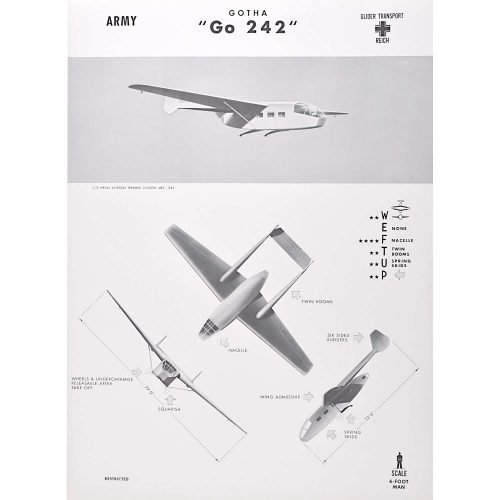
Army Gotha "Go 242"
Aeroplane identification poster, published 1942 63 x 47 cm A particularly unusual style of aeroplane identification poster, owing to the very arty images. Most such posters rely on very plain silhouettes, this series - and we have several in this series; view them here - have a much more arty approach to the task with shading and an interesting angle view. The Gotha Go 242 was a transport glider used by the Luftwaffe during World War II. It was designed by Albert Kalkert in response to the request for a heavy transport glider to replace the DFS 230 which was then in service. The requirement was for a glider capable of carrying 20 fully laden troops, or equivalent cargo. Two prototypes flew in 1941 and the type quickly entered production, with a total of 1,528 being built. In service, Go 242s were towed into the air by Heinkel He 111s or Junkers Ju 52s. Most saw service in the Mediterranean, North Africa and Aegean. Ju 87D-2s had strengthened rear fuselage and combined tailwheel and hook for towing the Go 242. Today, there are two surviving 242s - one in the Musée de la Resistance du Vercors in Valence, France, and the other in the Technik Museum and Luftwaffenmuseum der Bundeswehr in Berlin, Germany. Condition: generally very good. If you are interested, please email info@manningfineart.co.uk or call us on 07929 749056. -
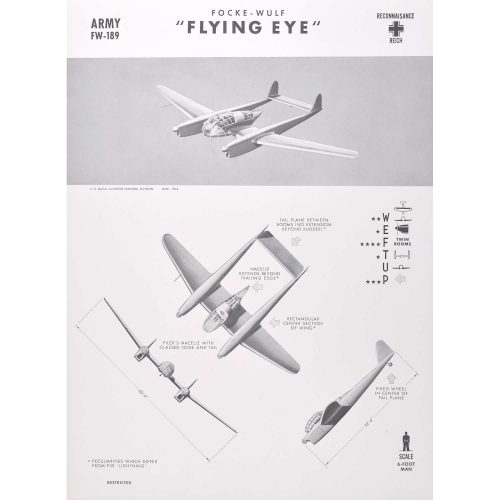
Army FW-189 "Flying Eye"
Aeroplane identification poster, published 1942 63 x 47 cm A particularly unusual style of aeroplane identification poster, owing to the very arty images. Most such posters rely on very plain silhouettes, this series - and we have several in this series; view them here - have a much more arty approach to the task with shading and an interesting angle view. The Focke-Wulf Fw 189 Uhu ("Eagle Owl") was a German twin-engine, twin-boom, three-seat tactical reconnaissance and army cooperation aircraft. It first flew in 1938, entered service in 1940 and was produced until mid-1944. It was nicknamed the “Flying Eye.” Patrolling the vast flatlands of Ukraine and Belarus, the Flying Eye was used extensively on the Eastern Front with great success. It was nicknamed "Rama" ("frame") by Soviet forces, in reference to its distinctive tailboom and stabiliser shapes, which gave it its characteristic quadrangular appearance. Despite its low speed, the Fw 189's manoeuvrability made it a difficult target for attacking Soviet fighters. When attacked, the Flying Eye was often able to out-turn enemy fighters by simply flying in a tight circle. Condition: generally very good. If you are interested, please email info@manningfineart.co.uk or call us on 07929 749056. -
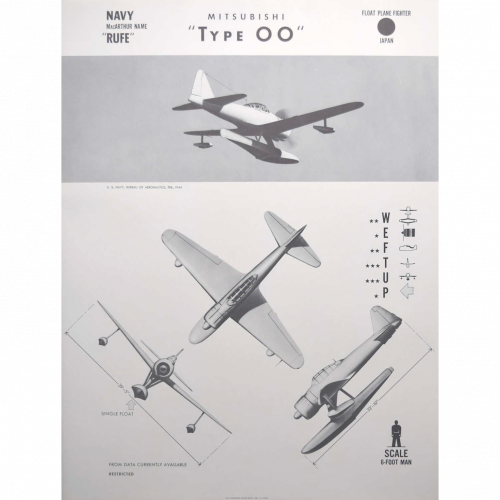
"Rufe" Mitsubishi "Type OO"
Aeroplane identification poster, published 1942 63 x 47 cm A particularly unusual style of aeroplane identification poster, owing to the very arty images. Most such posters rely on very plain silhouettes, this series - and we have several in this series; view them here - have a much more arty approach to the task with shading and an interesting angle view. This Japanese floatplane, known to the Allies as a "Rufe", was developed from the Mitsubishi A6M Type 0 - the famous ''Zero'' figher, mainly to support amphibious operations and defend remote bases. It was based on the A6M-2 Model 11 fuselage, with a modified tail and added floats. A total of 327 were built, including the original prototype. The aircraft was deployed in 1942 and was only used in operations taking place in the Aleutians and Solomon Islands. Such seaplanes were effective in harassing American patrol torpedo boats at night. They could also drop flares to illuminate the American boats which were vulnerable to destroyer gunfire, and depended on cover of darkness. Condition: generally very good. If you are interested, please email info@manningfineart.co.uk or call us on 07929 749056. -
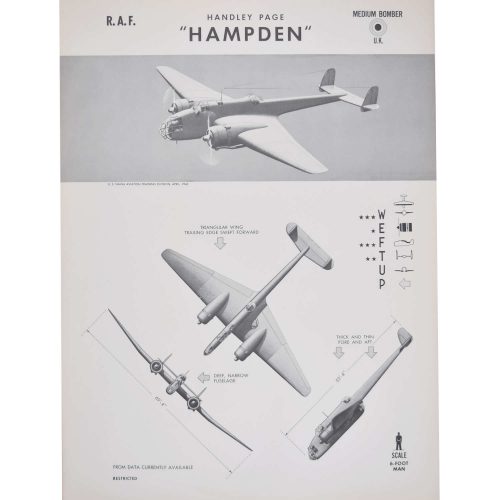
Royal Air Force Handley Page "Hampden" Bomber
Aeroplane identification poster, published 1943 63 x 47 cm A particularly unusual style of aeroplane identification poster, owing to the very arty images. Most such posters rely on very plain silhouettes, this series - and we have several in this series; view them here - have a much more arty approach to the task with shading and an interesting angle view. The Handley Page HP.52 Hampden is a British twin-engine medium bomber that was operated by the Royal Air Force (RAF). It was part of the trio of large twin-engine bombers procured for the RAF, joining the Armstrong Whitworth Whitley and Vickers Wellington. The Hampden was powered by Bristol Pegasus radial engines but a variant known as the Handley Page Hereford had in-line Napier Daggers. The Hampden served in the early stages of the Second World War, bearing the brunt of the early bombing war over Europe, taking part in the first night raid on Berlin and the first 1,000-bomber raid on Cologne. When it became obsolete, after a period of mainly operating at night, it was retired from RAF Bomber Command service in late 1942. By 1943, the rest of the trio were being superseded by the larger four-engined heavy bombers such as the Avro Lancaster. Condition: generally very good. If you are interested, please email info@manningfineart.co.uk or call us on 07929 749056. -
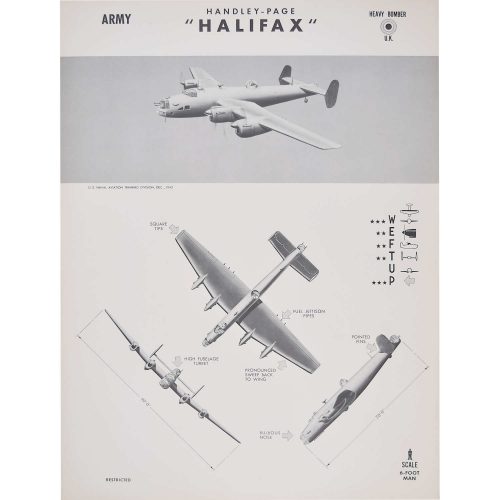
Handley-Page "Halifax"
Aeroplane identification poster, published 1942 63 x 47 cm A particularly unusual style of aeroplane identification poster, owing to the very arty images. Most such posters rely on very plain silhouettes, this series - and we have several in this series; view them here - have a much more arty approach to the task with shading and an interesting angle view. The Halifax bomber was a twin-engined bomber that entered service with the RAF in 1940. Viewed by Arthur ''Bomber'' Harris as inferior to the Lancaster, on account of its smaller payload, the crews preferred it. 1,833 aircraft were lost in service with Bomber Command, across a total of 82,733 operations. Only three survive, one at the Yorkshire Air Museum in Elvington (based on a fuselage that had been in use at a chicken farm following a crash near Stornoway), one at the National Air Force Museum of Canada (which was discovered in 1991 in Norway and subsequently restored), and one at the RAF Museum in London (that crash landed in Norway following an attack on the German battleship Tirpitz; rediscovered in 1971, it has been left unrestored). Condition: generally very good. If you are interested, please email info@manningfineart.co.uk or call us on 07929 749056. -
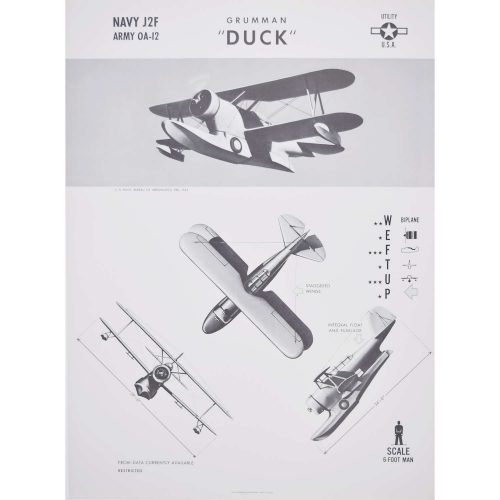
Navy and Army Grumman "Duck"
Aeroplane identification poster, published 1942 63 x 47 cm A particularly unusual style of aeroplane identification poster, owing to the very arty images. Most such posters rely on very plain silhouettes, this series - and we have several in this series; view them here - have a much more arty approach to the task with shading and an interesting angle view. The Grumman J2F Duck was an American single-engine amphibious biplane. It was used by each major branch of the U.S. armed forces from the mid-1930s until just after World War II, primarily for utility and air-sea rescue duties. It was also used by the Argentine Navy, who took delivery of their first J2F in 1937. Apart from general utility and light transport duties, its missions included mapping, reconnaissance, anti-submarine patrol, air-sea rescue work, photographic surveys, and target tug. Condition: generally very good. If you are interested, please email info@manningfineart.co.uk or call us on 07929 749056. -
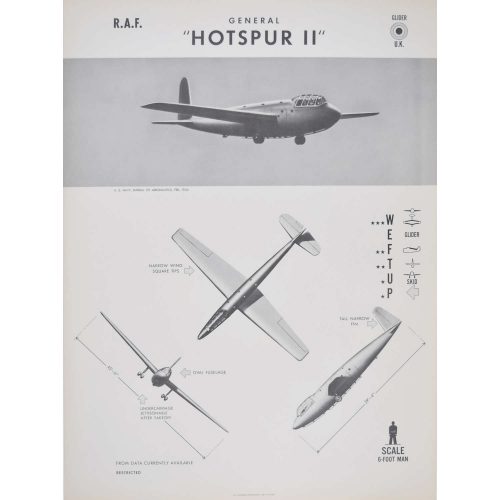
1942 RAF General Hotspur II
Aeroplane identification poster, published 1942 63 x 47 cm A particularly unusual style of aeroplane identification poster, owing to the very arty images. Most such posters rely on very plain silhouettes, this series - and we have several in this series; view them here - have a much more arty approach to the task with shading and an interesting angle view. A particularly unusual style of aeroplane recognition poster, owing to the very arty images. Most such posters rely on very plain silhouettes, this series - and we have several in this series - have a much more arty approach to the task with shading and an interesting angle view. The General Aircraft GAL.48 Hotspur was a military glider designed and built by the British company General Aircraft Ltd during World War II. When the British airborne establishment was formed in 1940 by order of Prime Minister Winston Churchill, it was decided that gliders would be used to transport airborne troops into battle. General Aircraft Ltd were given a contract by the Ministry of Aircraft Production in June 1940 to design and produce an initial glider for use by the airborne establishment, which resulted in the Hotspur. Conceived as an "assault" glider which necessitated a compact design and no more than eight troops carried, tactical philosophy soon favoured larger numbers of troops being sent into battle aboard gliders. Due to this, the Hotspur was mainly relegated to training where it did excel and it became the basic trainer for the glider schools that were formed. The Hotspur was named after Sir Henry Percy, a significant captain during the Anglo-Scottish wars who was also known as "Hotspur". A Hotspur Mark II (HH268) replica is on display at the Museum of Army Flying in Hampshire, England. The front fuselage of a Hotspur was preserved at the Parachute Regiment And Airborne Forces Museum in Aldershot prior to the museum''s 2007 closing, in anticipation of a move to the Imperial War Museum Duxford. Condition: generally very good. If you are interested, please email info@manningfineart.co.uk or call us on 07929 749056. -
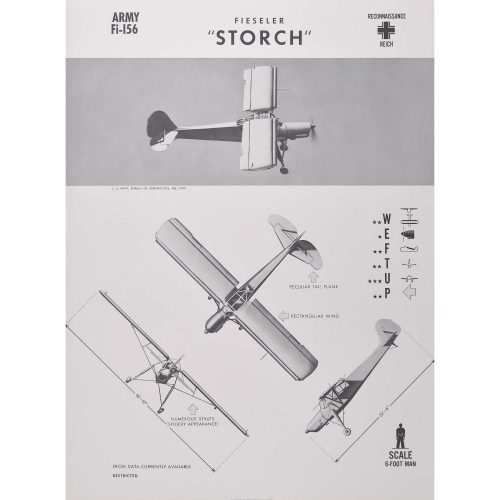
Army Fi-156 Fieseler "Storch"
Aeroplane identification poster, published 1944 63 x 47 cm A particularly unusual style of aeroplane identification poster, owing to the very arty images. Most such posters rely on very plain silhouettes, this series - and we have several in this series; view them here - have a much more arty approach to the task with shading and an interesting angle view. The Fieseler Fi 156 Storch, meaning "stork", was a small German liaison aircraft built by Fieseler before and during World War II. It was notable for its excellent short-takeoff-and-landing performance and low stall speed of 31 mph.The Douglas Skymaster was a four-engine transport aircraft used by the United States Army Air Forces in World War II and the Korean War. Like the Douglas C-47 Skytrain (the Skytrain poster from the same series is also available in our storefront), the Skymaster was derived from a civilian airliner, the Douglas DC-4. The Storch was deployed in all European and North African theatres of World War II. In addition to its liaison function, a number were used to fly a battalion of Infantry Regiment Grossdeutschland behind enemy lines during the invasion of Belgium. In 1943, the Storch played a role in Operation Eiche, the rescue of deposed Italian dictator Benito Mussolini from a boulder-strewn mountain-top near the Gran Sasso. Even though the mountain was surrounded by Italian troops, German commando Otto Skorzeny and 90 paratroopers used gliders to land on the peak and quickly captured it. However, the problem of how to get back off remained. A Focke-Achgelis Fa 223 helicopter was sent, but it broke down en route. Instead, pilot Heinrich Gerlach flew over in a Storch. After Mussolini and Skorzeny had boarded the aircraft, the Storch took off to 250 ft, even though the aircraft was overloaded. A Storch was the last aircraft shot down by the Allies on the Western Front. Condition: generally very good. If you are interested, please email info@manningfineart.co.uk or call us on 07929 749056. -
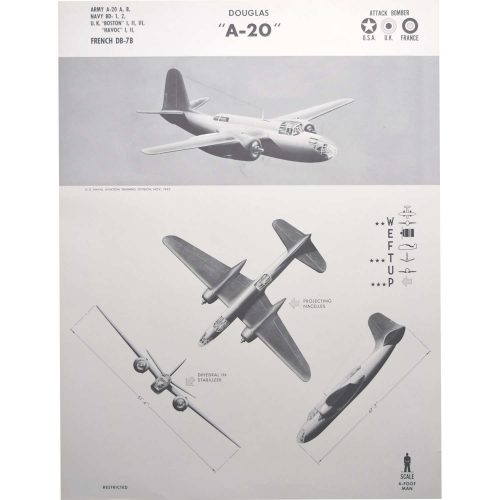
Army A-20 A, B, Navy BD- 1, 2, UK "Boston" I, II, III, "Havoc" I, II, French DB-7B Douglas "A-20"
Aeroplane identification poster, published 1942 63 x 47 cm A particularly unusual style of aeroplane identification poster, owing to the very arty images. Most such posters rely on very plain silhouettes, this series - and we have several in this series; view them here - have a much more arty approach to the task with shading and an interesting angle view. The Douglas A-20 was a medium bomber, attack aircraft, night intruder, night fighter, and reconnaissance aircraft of World War II. Designed to meet an Army Air Corps requirement for a bomber, it was ordered by France for their air force before the USAAC decided it would also meet their requirements. French DB-7s were the first to see combat. The A-20 served with several Allied air forces, principally the United States Army Air Forces (USAAF), the Soviet Air Forces (VVS), Soviet Naval Aviation (AVMF), and the Royal Air Force (RAF) of the United Kingdom. A total of 7,478 aircraft were built, of which more than a third served with Soviet units. It was also used by the air forces of Australia, South Africa, France, and the Netherlands during the war. Condition: generally very good. If you are interested, please email info@manningfineart.co.uk or call us on 07929 749056. -
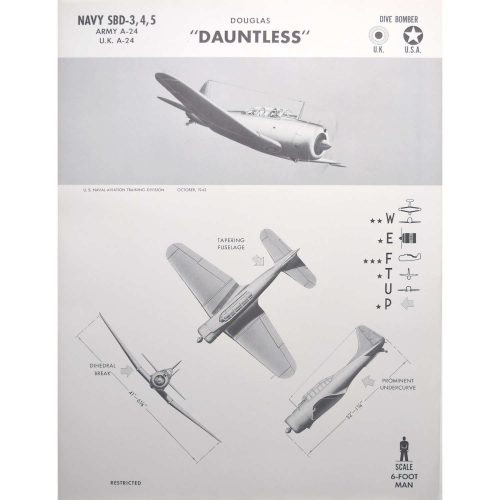
Navy SBD-3, 4, 5, Army A-24 Douglas "Dauntless"
Aeroplane identification poster, published 1942 63 x 47 cm A particularly unusual style of aeroplane identification poster, owing to the very arty images. Most such posters rely on very plain silhouettes, this series - and we have several in this series; view them here - have a much more arty approach to the task with shading and an interesting angle view. The Douglas SBD Dauntless was a World War II American naval scout plane and dive bomber that was manufactured by Douglas Aircraft from 1940 through 1944. The SBD ("Scout Bomber Douglas") was the United States Navy''s main carrier-based scout/dive bomber from mid-1940 through mid-1944. The SBD was also flown by the United States Marine Corps, both from land air bases and aircraft carriers. The SBD is best remembered as the bomber that delivered the fatal blows to the Japanese carriers at the Battle of Midway in June 1942. During Midway, four squadrons of Dauntless dive bombers attacked and sank or fatally damaged all four Japanese fleet carriers present, disabling three of them in the span of just six minutes (Akagi, Kaga, and Sōryū) and, later in the day, Hiryū. During its combat service, the SBD proved to be an excellent naval scout plane and dive bomber. It possessed long range, good handling characteristics, manoeuvrability, potent bomb load, great diving characteristics from the perforated dive brakes, good defensive armament, and ruggedness. Condition: generally very good. If you are interested, please email info@manningfineart.co.uk or call us on 07929 749056. -
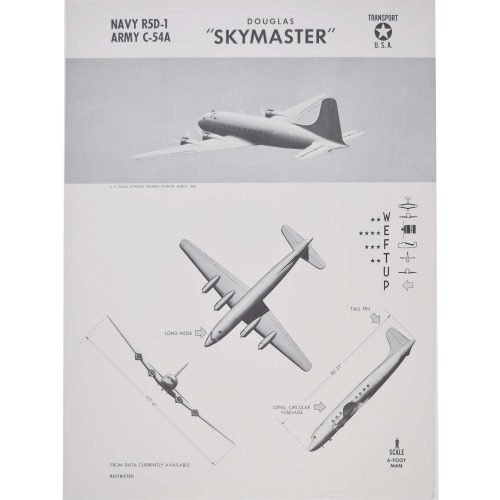
1942 Navy R5D-1 Army C-54A Douglas "Skymaster"
Aeroplane identification poster, published 1942 63 x 47 cm A particularly unusual style of aeroplane identification poster, owing to the very arty images. Most such posters rely on very plain silhouettes, this series - and we have several in this series; view them here - have a much more arty approach to the task with shading and an interesting angle view. The Douglas Skymaster was a four-engine transport aircraft used by the United States Army Air Forces in World War II and the Korean War. Like the Douglas C-47 Skytrain (the Skytrain poster from the same series is also available in our storefront), the Skymaster was derived from a civilian airliner, the Douglas DC-4. To meet military requirements, the first civil production aircraft had four additional auxiliary fuel tanks in the main cabin which reduced the passenger seats to 26. The following batch of aircraft, designated C-54A, were built with a stronger floor and a cargo door with a hoist and winch. The first C-54A was delivered in February 1943. Skymasters used by the United States Navy were designated Douglas R5D. As well as being used for cargo transport, the C-54 also carried presidents, prime ministers, and military staff. Dozens of variants of the C-54 were employed in a wide variety of non-combat roles such as air-sea rescue, scientific and military research, and missile tracking and recovery. During the Berlin Airlift it hauled coal and food supplies to West Berlin. After the Korean War it continued to be used for military and civilian uses by more than 30 countries. Condition: generally very good. If you are interested, please email info@manningfineart.co.uk or call us on 07929 749056. -
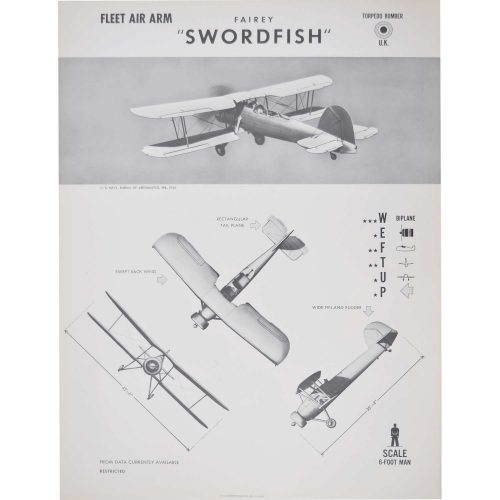
Fairey Swordfish
Aeroplane identification poster, published 1942 63 x 47 cm A particularly unusual style of aeroplane identification poster, owing to the very arty images. Most such posters rely on very plain silhouettes, this series - and we have several in this series; view them here - have a much more arty approach to the task with shading and an interesting angle view. The Fairey Swordfish is a biplane torpedo bomber designed by the Fairey Aviation Company. Originating in the early 1930s, the Swordfish, nicknamed "Stringbag", was operated by the Fleet Air Arm of the Royal Navy, it was also used by the Royal Air Force (RAF), as well as several overseas operators, including the Royal Canadian Air Force (RCAF) and the Royal Netherlands Navy. It was initially operated primarily as a fleet attack aircraft. During its later years, the Swordfish became increasingly used as an anti-submarine and training platform. The type was in frontline service throughout the Second World War. Despite being obsolete by 1939, the Swordfish achieved some spectacular successes during the war. Notable events included sinking one battleship and damaging two others of the Regia Marina (the Italian Navy) during the Battle of Taranto, and the famous attack on the Bismarck, which contributed to her eventual demise. By the end of the war, the Swordfish held the distinction of having caused the destruction of a greater tonnage of Axis shipping than any other Allied aircraft. The Swordfish remained in front-line service until V-E Day, having outlived multiple aircraft that had been intended to replace it in service. Condition: generally very good. If you are interested, please email info@manningfineart.co.uk or call us on 07929 749056. -
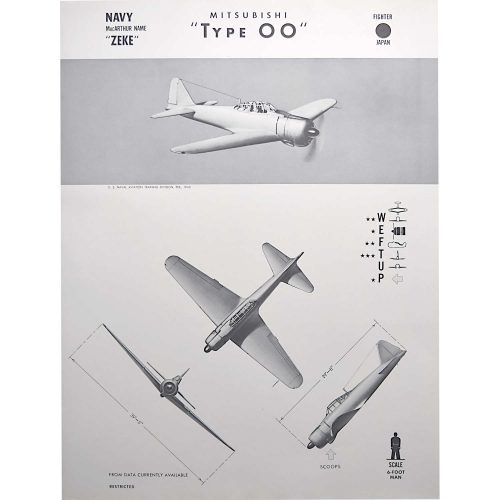
US Naval Aviation Training Division
MacArthur name "Zeke" or Zero Mitsubishi "Type 00" - Japanese fighter plane
Aeroplane identification poster, published 1943 63 x 47 cm A particularly unusual style of aeroplane identification poster, owing to the very arty images. Most such posters rely on very plain silhouettes, this series - and we have several in this series; view them here - have a much more arty approach to the task with shading and an interesting angle view. The Mitsubishi A6M "Zero" was a long-range carrier-based fighter aircraft formerly manufactured by Mitsubishi Aircraft Company, a part of Mitsubishi Heavy Industries, and was operated by the Imperial Japanese Navy from 1940 to 1945. The official Allied reporting name was "Zeke", although the name "Zero" (from Type 0) was used colloquially by the Allies as well. The Zero was considered to have been the most capable carrier-based fighter in the world when it was introduced early in World War II, combining excellent manoeuvrability and very long range. The Imperial Japanese Navy Air Service (IJNAS) also frequently used it as a land-based fighter. In early combat operations, the Zero gained a reputation as a dogfighter, achieving an outstanding kill ratio of 12 to 1, but by mid-1942 a combination of new tactics and the introduction of better equipment enabled Allied pilots to engage the Zero on generally equal terms. The Zero continued to serve in a front-line role until the end of the war in the Pacific; during the final phases, it was also adapted for use in kamikaze operations. Japan produced more Zeros than any other model of combat aircraft during the Second World War. Condition: generally very good. If you are interested, please email info@manningfineart.co.uk or call us on 07929 749056. -
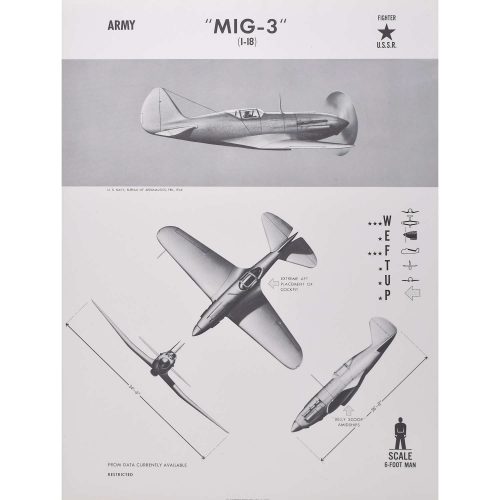
US Naval Aviation Training Division
MIG-3
Aeroplane identification poster, published 1942 63 x 47 cm A particularly unusual style of aeroplane identification poster, owing to the very arty images. Most such posters rely on very plain silhouettes, this series - and we have several in this series; view them here - have a much more arty approach to the task with shading and an interesting angle view. The Mikoyan-Gurevich MIG-3 was a Soviet fighter and interceptor aircraft used during World War II. It was a development of the MIG-1 by the Experimental Design Department of Factory No. 1 to remedy problems found during the MIG-1's development and operations. On 22 June 1941, at the beginning of Operation Barbarossa, some 981 MIG-3s were in service with the Soviet Air Forces, the Soviet Air Defence Forces, and Soviet Naval Aviation. The MIG-3 was difficult to fly in peacetime and much more so in combat. Originally designed as a high-altitude fighter-interceptor, combat over the Eastern Front was generally at lower altitudes, where it was inferior to the German Messerschmitt Bf 109 (a poster of which is available in our storefront) as well as most of its Soviet contemporaries. It was also pressed into service as a fighter-bomber during the autumn of 1941 but it was equally unsuited for this. The losses suffered in combat were very high, in percentage the highest among all the VVS fighters, with 1,432 shot down. Condition: generally very good. If you are interested, please email info@manningfineart.co.uk or call us on 07929 749056. -
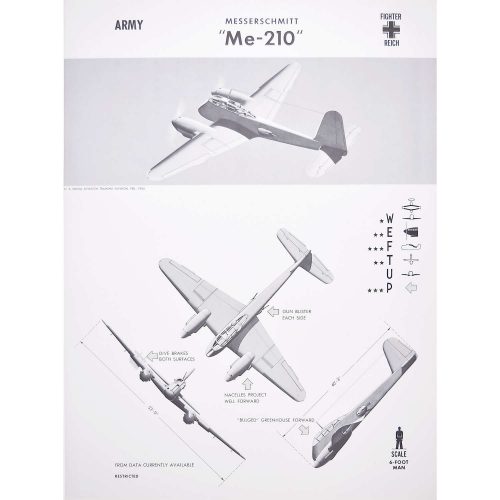
US Naval Aviation Training Division
Messerschmitt BF 210
Aeroplane identification poster, published 1942 63 x 47 cm A particularly unusual style of aeroplane identification poster, owing to the very arty images. Most such posters rely on very plain silhouettes, this series - and we have several in this series; view them here - have a much more arty approach to the task with shading and an interesting angle view. The Messerschmitt Me 210 was a two-seater German heavy fighter and ground-attack aircraft of World War II. Initial development of the 210 was started by Messerschmitt in 1938 at the request of the Luftwaffe. Condition: generally very good. If you are interested, please email info@manningfineart.co.uk or call us on 07929 749056. -
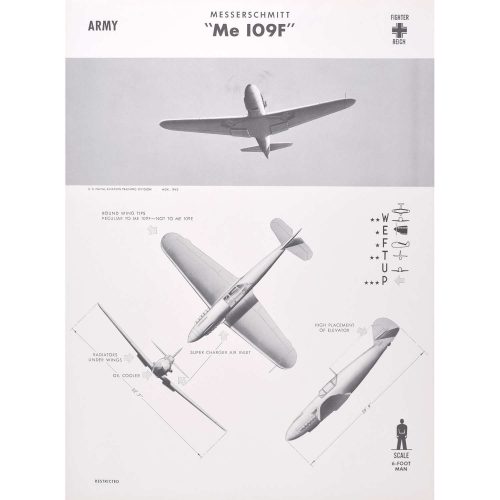
US Naval Aviation Training Division
Messerschmitt BF 109
Aeroplane identification poster, published 1942 63 x 47 cm A particularly unusual style of aeroplane identification poster, owing to the very arty images. Most such posters rely on very plain silhouettes, this series - and we have several in this series; view them here - have a much more arty approach to the task with shading and an interesting angle view. The Messerschmitt Bf 109 is a German World War II fighter aircraft that was, along with the Focke-Wulf Fw 190, the backbone of the Luftwaffe's fighter force. The Bf 109 first saw operational service in 1937 during the Spanish Civil War and was still in service at the dawn of the jet age at the end of World War II in 1945. It was one of the most advanced fighters when it first appeared, with an all-metal monocoque construction, a closed canopy, and retractable landing gear. It was powered by a liquid-cooled, inverted-V12 aero engine. It was called the Me 109 by Allied aircrew and some German aces, even though this was not the official German designation. It was designed by Willy Messerschmitt and Robert Lusser who worked at Bayerische Flugzeugwerke during the early to mid-1930s. It was conceived as an interceptor, although later models were developed to fulfil multiple tasks, serving as bomber escort, fighter-bomber, day-, night-, all-weather fighter, ground-attack aircraft, and reconnaissance aircraft. It was supplied to several states during World War II and served with several countries for many years after the war. The Bf 109 is the most produced fighter aircraft in history, with a total of 33,984 airframes produced from 1936 to April 1945. Some of the Bf 109 production took place in Nazi concentration camps through slave labor. The Bf 109 was flown by the three top-scoring fighter aces of all time, who claimed 928 victories among them while flying with Jagdgeschwader 52, mainly on the Eastern Front. The highest-scoring, Erich Hartmann, was credited with 352 victories. The aircraft was also flown by Hans-Joachim Marseille, the highest-scoring ace in the North African Campaign who shot down 158 enemy aircraft. It was also flown by many aces from other countries fighting with Germany, notably the Finn Ilmari Juutilainen, the highest-scoring non-German ace. Pilots from Italy, Romania, Croatia, Bulgaria, and Hungary also flew the Bf 109. Through constant development, the Bf 109 remained competitive with the latest Allied fighter aircraft until the end of the war. Condition: generally very good. If you are interested, please email info@manningfineart.co.uk or call us on 07929 749056. -
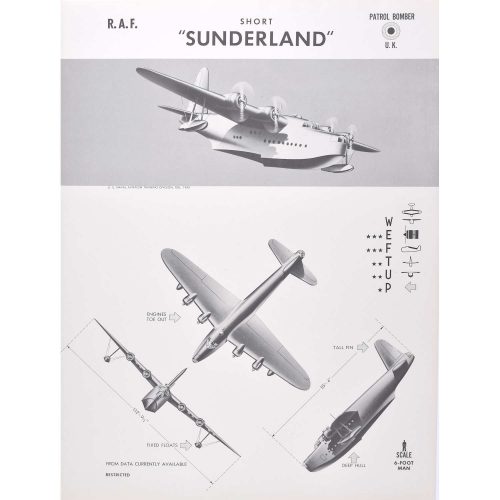
US Naval Aviation Training Division
Short Sunderland
Aeroplane identification poster, published 1942 63 x 47 cm A particularly unusual style of aeroplane identification poster, owing to the very arty images. Most such posters rely on very plain silhouettes, this series - and we have several in this series; view them here - have a much more arty approach to the task with shading and an interesting angle view. The Avro Lancaster is a British Second World War heavy bomber. It was designed and manufactured by Avro as a contemporary of the Handley Page Halifax, both bombers having been developed to the same specification, as well as the Short Stirling, all three aircraft being four-engined heavy bombers adopted by the Royal Air Force (RAF) during the same wartime era. The Short Sunderland was a British flying boat patrol bomber, developed and constructed by Short Brothers for the Royal Air Force (RAF). The aircraft took its service name from the town (latterly, city) and port of Sunderland in North East England. The Sunderland was one of the most powerful and widely used flying boats throughout the Second World War. In addition to the RAF, the type was operated by other Allied military air wings, including the Royal Australian Air Force (RAAF), Royal Canadian Air Force (RCAF), South African Air Force (SAAF), Royal New Zealand Air Force (RNZAF), French Navy, Norwegian Air Force, and the Portuguese Navy. During the conflict, the Sunderland was heavily involved in Allied efforts to counter the threat posed by German U-boats in the Battle of the Atlantic. On 17 July 1940, a RAAF Sunderland (of No. 10 Squadron) performed the type's first unassisted U-boat kill. The Sunderland also played a major role in the Mediterranean theatre, performing maritime reconnaissance flights and logistical support missions. During the evacuation of Crete, shortly after the German invasion of the island, several aircraft were used to transport troops. Numerous unarmed Sunderlands were also flown by civil operator British Overseas Airways Corporation (BOAC), traversing routes as far afield as the Pacific Ocean. Condition: generally very good, occasional handling marks. If you are interested, please email info@manningfineart.co.uk or call us on 07929 749056. -
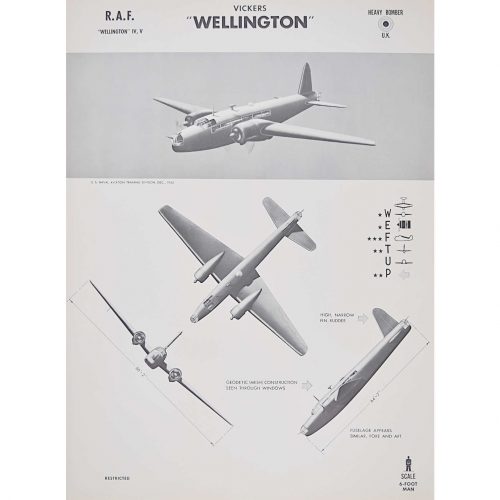
US Naval Aviation Training Division
Vickers Wellington
Aeroplane identification poster, 1942 63 x 47 cm A particularly unusual style of aeroplane identification poster, owing to the very arty images. Most such posters rely on very plain silhouettes, this series - and we have several in this series; view them here - have a much more arty approach to the task with shading and an interesting angle view. The Vickers Wellington was a British twin-engined, long-range medium bomber. It was designed during the mid-1930s at Brooklands in Weybridge, Surrey. Led by Vickers-Armstrongs' chief designer Rex Pierson; a key feature of the aircraft is its geodetic airframe fuselage structure, which was principally designed by Barnes Wallis. Development had been started in response to Air Ministry Specification B.9/32, issued in the middle of 1932, for a bomber for the Royal Air Force. This specification called for a twin-engined day bomber capable of delivering higher performance than any previous design. Other aircraft developed to the same specification include the Armstrong Whitworth Whitley and the Handley Page Hampden. During the development process, performance requirements such as for the tare weight changed substantially, and the engine used was not the one originally intended. The Wellington was used as a night bomber in the early years of the Second World War, performing as one of the principal bombers used by Bomber Command. During 1943, it started to be superseded as a bomber by the larger four-engined "heavies" such as the Avro Lancaster. The Wellington continued to serve throughout the war in other duties, particularly as an anti-submarine aircraft. It holds the distinction of having been the only British bomber that was produced for the duration of the war, and of having been produced in a greater quantity than any other British-built bomber. The Wellington remained as first-line equipment when the war ended, although it had been increasingly relegated to secondary roles. The Wellington was one of two bombers named after Arthur Wellesley, 1st Duke of Wellington, the other being the Vickers Wellesley. A larger heavy bomber aircraft designed to Specification B.1/35, the Vickers Warwick, was developed in parallel with the Wellington; the two aircraft shared around 85% of their structural components. Many elements of the Wellington were also re-used in a civil derivative, the Vickers VC.1 Viking. If you are interested, please email info@manningfineart.co.uk or call us on 07929 749056. -
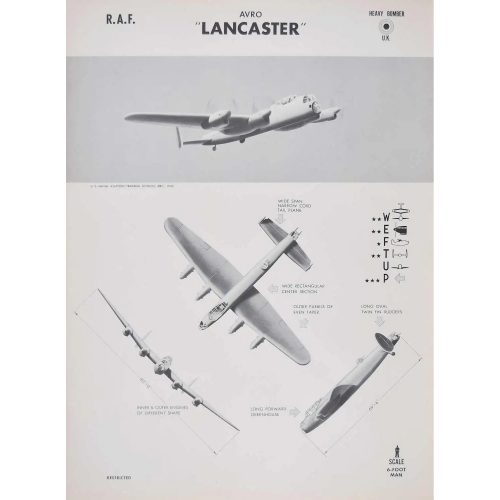
US Naval Aviation Training Division
Avro Lancaster
Aeroplane identification poster, published 1942 63 x 47 cm A particularly unusual style of aeroplane identification poster, owing to the very arty images. Most such posters rely on very plain silhouettes, this series - and we have several in this series; view them here - have a much more arty approach to the task with shading and an interesting angle view. The Avro Lancaster is a British Second World War heavy bomber. It was designed and manufactured by Avro as a contemporary of the Handley Page Halifax, both bombers having been developed to the same specification, as well as the Short Stirling, all three aircraft being four-engined heavy bombers adopted by the Royal Air Force (RAF) during the same wartime era. The Lancaster has its origins in the twin-engine Avro Manchester which had been developed during the late 1930s in response to the Air Ministry Specification P.13/36 for a capable medium bomber for "world-wide use". Originally developed as an evolution of the Manchester (which had proved troublesome in service and was retired in 1942), the Lancaster was designed by Roy Chadwick and powered by four Rolls-Royce Merlins and in one version, Bristol Hercules engines. It first saw service with RAF Bomber Command in 1942 and as the strategic bombing offensive over Europe gathered momentum, it was the main aircraft for the night-time bombing campaigns that followed. As increasing numbers of the type were produced, it became the principal heavy bomber used by the RAF, the Royal Canadian Air Force (RCAF) and squadrons from other Commonwealth and European countries serving within the RAF, overshadowing the Halifax and Stirling. A long, unobstructed bomb bay meant that the Lancaster could take the largest bombs used by the RAF, including the 4,000 lb (1,800 kg), 8,000 lb (3,600 kg) and 12,000 lb (5,400 kg) blockbusters, loads often supplemented with smaller bombs or incendiaries. The "Lanc", as it was known colloquially, became one of the most heavily used of the Second World War night bombers, "delivering 608,612 long tonnes of bombs in 156,000 sorties". The versatility of the Lancaster was such that it was chosen to equip 617 Squadron and was modified to carry the Upkeep "bouncing bomb" designed by Barnes Wallis for Operation Chastise, the attack on German Ruhr valley dams. Although the Lancaster was primarily a night bomber, it excelled in many other roles, including daylight precision bombing, for which some Lancasters were adapted to carry the 12,000 lb (5,400 kg) Tallboy and then the 22,000 lb (10,000 kg) Grand Slam earthquake bombs (also designed by Wallis). This was the largest payload of any bomber in the war. In 1943, a Lancaster was converted to become an engine test bed for the Metropolitan-Vickers F.2 turbojet. Lancasters were later used to test other engines, including the Armstrong Siddeley Mamba and Rolls-Royce Dart turboprops and the Avro Canada Orenda and STAL Dovern turbojets. Postwar, the Lancaster was supplanted as the main strategic bomber of the RAF by the Avro Lincoln, a larger version of the Lancaster. The Lancaster took on the role of long range anti-submarine patrol aircraft (later supplanted by the Avro Shackleton) and air-sea rescue. It was also used for photo-reconnaissance and aerial mapping, as a flying tanker for aerial refuelling and as the Avro Lancastrian, a long-range, high-speed, transatlantic passenger and postal delivery airliner. In March 1946, a Lancastrian of BSAA flew the first scheduled flight from the new London Heathrow Airport. Condition: generally very good, occasional handling marks. If you are interested, please email info@manningfineart.co.uk or call us on 07929 749056. -
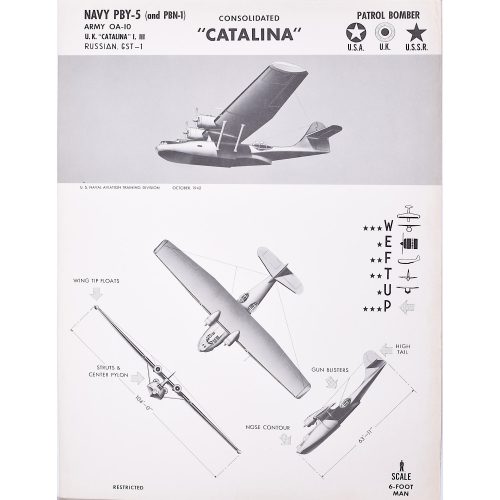
US Naval Aviation Training Division
Consolidated PBY Catalina World War 2 US airplane
Aeroplane identification poster, 1942 63 x 47 cm A particularly unusual style of aeroplane identification poster, owing to the very arty images. Most such posters rely on very plain silhouettes, this series - and we have several in this series (click here) - have a much more arty approach to the task with shading and an interesting angle view. The PBY Catalina is a flying boat used extensively during World War 2 in anti-submarine patrols, air-sea rescue, patrol bombing and convoy escort. It served militarily until the 1980s and was still being used in the 2010s as a waterbomber for firefighting. The RCAF called it the Canso. If you are interested, please email info@manningfineart.co.uk or call us on 07929 749056. -
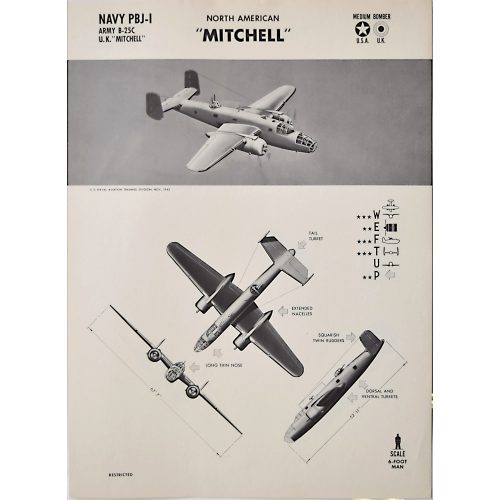
US Naval Aviation Training Division
B-25 Bomber North American Mitchell World War 2 US airplane
Original aeroplane identification poster, 1942 63 x 47 cm A particularly unusual style of aeroplane identification poster, owing to the very arty images. Most such posters rely on very plain silhouettes, this series - and we have several in this series - have a much more arty approach to the task with shading and an interesting angle view. Manufactured by North American Aviation and named in honour of Major General William 'Billy' Mitchell, a pioneer of US military aviation its first flight was in 1940 but it remained in service until 1979 (in the Indonesian air force). A particularly durable aircraft, one from the 321st Bomb Group was nicknamed 'Patches' on account of its (by the end of the war) 400 patched holes which had been painted with bright-yellow zinc chromate primer. Having completed over 300 missions and belly-landed six times the airframe was so distorted that 'straight-and-level' flight involved 8 degrees of left aileron trim and 6 degrees of right rudder causing the aircraft to 'crab' sideways through the air. Over one hundred B-25 Mitchells survive, with about 45 still airworthy. Seventeen flyable aircraft (and one hulk which was sacrificed to a crash scene) starred in the 1970 film 'Catch 22' fifteen of which still exist. If you are interested, please email info@manningfineart.co.uk or call us on 07929 749056. -
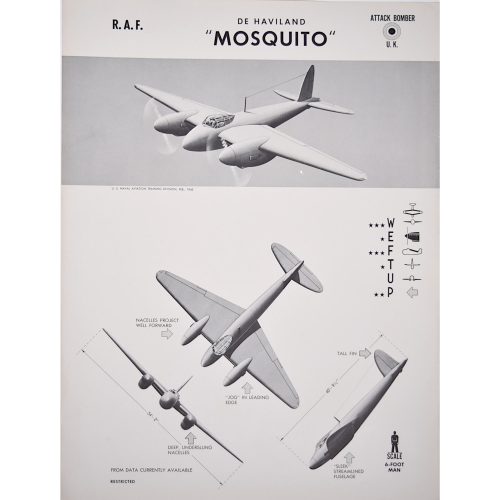
US Naval Aviation Training Division
DH Mosquito World War 2 US airplane
Original aeroplane identification poster, 1943 63 x 47 cm The Mosquito, the 'wooden wonder', was made entirely from wood to counteract metal shortages. Being wooden, it was very light, and when powered by two Merlin engines could outrun any German aeroplane, hence its use for Photographic Reconnaissance. Goering is reputed to have said: "In 1940 I could at least fly as far as Glasgow in most of my aircraft, but not now! It makes me furious when I see the Mosquito. I turn green and yellow with envy. The British, who can afford aluminium better than we can, knock together a beautiful wooden aircraft that every piano factory over there is building, and they give it a speed which they have now increased yet again. What do you make of that? There is nothing the British do not have. They have the geniuses and we have the nincompoops. When the war is over I shall buy a British radio set. Then at least I shall have something that works." If you are interested, please email info@manningfineart.co.uk or call us on 07929 749056. -
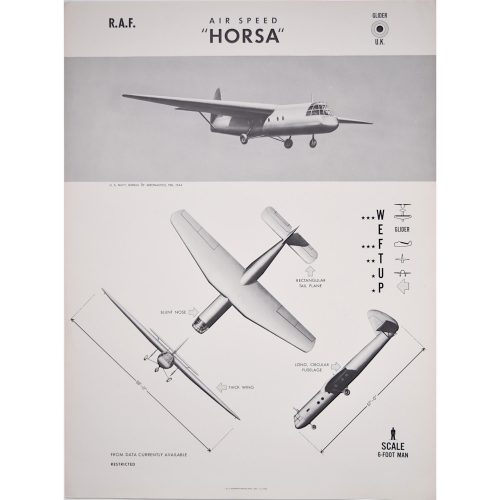
US Naval Aviation Training Division
Airspeed Horsa Glider World War 2 US airplane
Original aeroplane identification poster, 1943 63 x 47 cm In the days before helicopters it was gliders that allowed troops to be delivered to the ground. Essentially disposable aircraft (though obviously recovered where possible) they were light-weight and able to land in open fields where an aeroplane could not. Their ability to carry small tanks and other vehicles gave them a great advantage over simple paratroopers. Deployed to great effect in the D-Day Normandy landings and in the Market Garden advance, they were also widely used in Burma to supply the Chindits. One of the most terrifying methods of air transport during the War was the 'glider snatch'. A glider that had been used to deliver supplies or troops was reloaded with the wounded and then a passing aeroplane would pick up a rope attached to the front of the glider and snatch it into the air. The Horsa was a large glider, capable of accommodating 20-25 fully equipped paratroopers, and was first introduced in 1941. Made almost exclusively from wood - metal being in short supply - it was built by furniture factories. Between 3,799 and 5,000 Horsas were built - the varying numbers being down to the fact that many gliders were assembled at Maintenance Units rather than at the furniture factories (which lacked airfields). If you are interested, please email info@manningfineart.co.uk or call us on 07929 749056. -
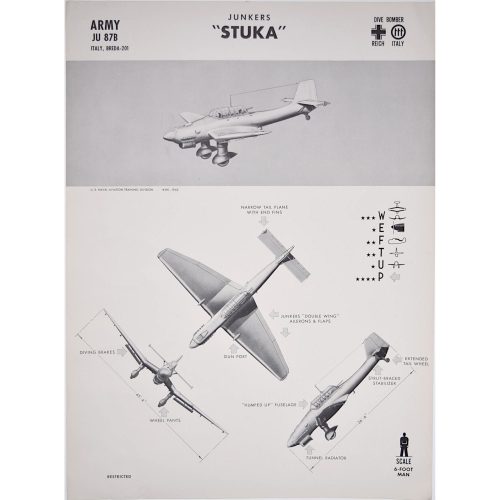
US Naval Aviation Training Division
Junkers Ju87 Stuka Dive Bomber - World War II aeroplane
Original aeroplane identification poster, 1943 63x47cm A particularly unusual style of aeroplane identification poster, owing to the very arty images. Most such posters rely on very plain silhouettes, this series - and we have several in this series (click here) - have a much more arty approach to the task with shading and an interesting angle view. Making its combat debut in 1937 with the Condor Legion during the Spanish Civil War it had a very distinctive silhouette as may be seen here. Essential to the rapid conquest of Norway, the Netherlands, Belgium and France in 1940 the Stuka was very effective against ground targets but vulnerable to fighter aircraft. It remained in service until the end of the War. If you are interested email info@manningfineart.co.uk or call us on 07929 749056. -
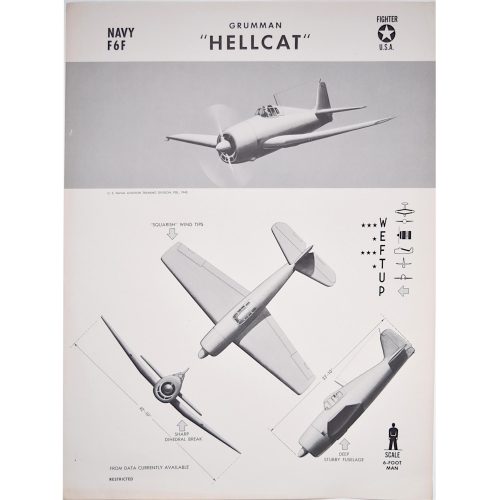
US Naval Aviation Training Division
Grumann F6F Hellcat World War 2 US airplane
Original aeroplane identification poster, 1943 63 x 47 cm The Grumman Hellcat was developed for the US Navy for the latter half of World War 2, becoming the dominant carrier-based aircraft being able to outperform the A6M Mitsubishi Zero. 12,275 were built in just over two years, being credited with 5,223 enemy kills - more than any other Allied naval aircraft. If you are interested, please email info@manningfineart.co.uk or call us on 07929 749056. -
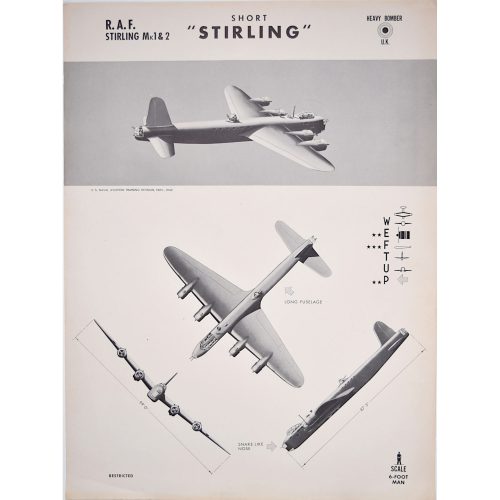
US Naval Aviation Training Division
Short Stirling World War 2 US airplane
Aeroplane identification poster, 1943 63 x 47 cm A particularly unusual style of aeroplane identification poster, owing to the very arty images. Most such posters rely on very plain silhouettes, this series - and we have several in this series (click here) - have a much more arty approach to the task with shading and an interesting angle view. Designed by Short Brothers, this was the RAF's first four-engined bomber entering service in 1941. Pilots liked its handling characteristics but the altitude ceiling was a matter of criticism and it was relegated to second-line duties in 1943 when the Halifax and Lancaster were available in sufficient numbers. It was subsequently used for mining harbours, as a glider tug and a supply aircraft. If you are interested, please email info@manningfineart.co.uk or call us on 07929 749056. -
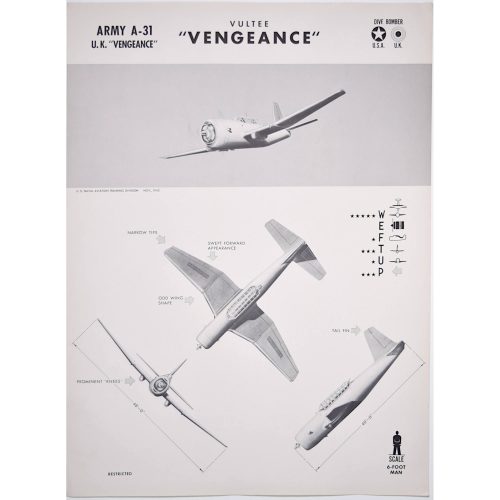
US Naval Aviation Training Division
1943 Vultee Vengeance World War 2 US airplane
Aeroplane identification poster, 1943 63 x 47 cm A particularly unusual style of aeroplane identification poster, owing to the very arty images. Most such posters rely on very plain silhouettes, this series - and we have several in this series (click here) - have a much more arty approach to the task with shading and an interesting angle view. Designed in 1940 as a single-engined dive bomber for the French Armée de l'Air, with deliveries scheduled for October 1940. With the fall of France in June 1940 the order was cancelled, but the British Royal Air Force ordered 200 of these dive bombers having been impressed by the Stuka. It was a reliable aircraft, stable in flight and in a dive. It was much used in Burma, this forgotten theatre of the war being regarded as a repository for otherwise unpopular and unwanted equipment, but where it proved very effective in bombing Japanese positions. If you are interested, please email info@manningfineart.co.uk or call us on 07929 749056. -

US Naval Aviation Training Division
Messerschmitt Bf 110 - World War II aeroplane
Aeroplane identification poster, 1943 63x47cm A particularly unusual style of aeroplane identification poster, owing to the very arty images. Most such posters rely on very plain silhouettes, this series - and we have several in this series (click here) - have a much more arty approach to the task with shading and an interesting angle view. A two-engined heavy fighter and fighter-bomber developed in German in the 1930s which saw service until the end of the war in 1945. It was a formidable radar-equipped night fighter with the top night-fighter ace Major Heinz-Wolfgang Schnaufer claiming 121 victories from 164 sorties. If you are interested email info@manningfineart.co.uk or call us on 07929 749056. -
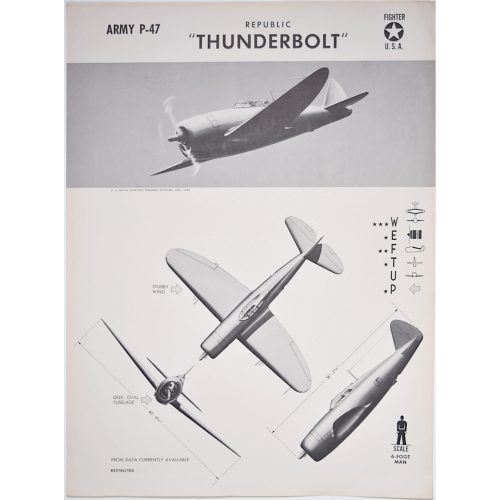
US Naval Aviation Training Division
Republic P47 Thunderbolt World War 2 US airplane
Aeroplane identification poster, 1943 63 x 47 cm A particularly unusual style of aeroplane identification poster, owing to the very arty images. Most such posters rely on very plain silhouettes, this series - and we have several in this series (click here) - have a much more arty approach to the task with shading and an interesting angle view. The Thunderbolt was produced between 1941 and 1945 as a fighter-bomber ground-attack airplane. POwered by a Pratt & Whitney R-2800 Double-Wasp engine it was successful both in European and Pacific theatres as one of the main USAAF fighters of the Second World War. Many remain airworthy, it being a popular 'warbird'. If you are interested, please email info@manningfineart.co.uk or call us on 07929 749056. -
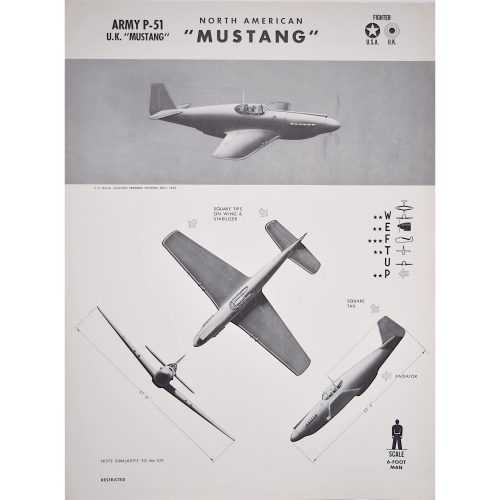
US Naval Aviation Training Division
North American Mustang P-51 World War 2 US airplane
Aeroplane identification poster, 1943 63x47cm A particularly unusual style of aeroplane identification poster, owing to the very arty images. Most such posters rely on very plain silhouettes, this series - and we have several in this series (click here) - have a much more arty approach to the task with shading and an interesting angle view. The Mustang is a long-range single-seat fighter/fighter-bomber that saw service during both the Second World War and Korean War. It was designed in 1940 by North American Aviation when they were commissioned to build Curtiss P-40 fighters under licence for the British Royal Air Force. Rather than build an old design, they designed this new aeroplane; the prototype was rolled out 102 days after the contract was signed. Powered by a Rolls-Royce Merlin engine over 15,000 were built with their most important role being escorting bombers over Germany. During World War II Mustang pilots accounted for a claimed 4,950 enemy aircraft. Today many survive and are a very popular 'warbird'. If you are interested email info@manningfineart.co.uk or call us on 07929 749056. -
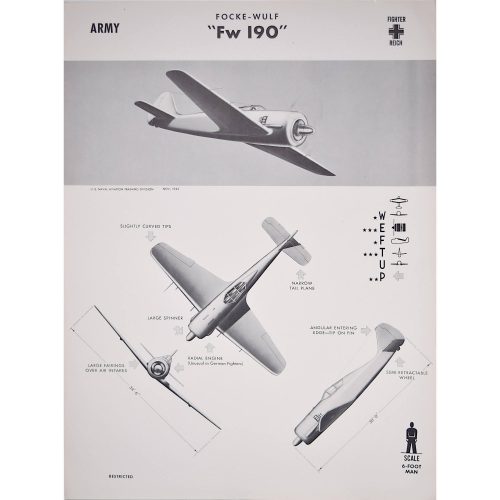
US Naval Aviation Training Division
Luftwaffe Focke-Wulf Fw190 - World War II aeroplane
Aeroplane identification poster, 1943 63 x 47cm A particularly unusual style of aeroplane identification poster, owing to the very arty images. Most such posters rely on very plain silhouettes, this series - and we have several in this series (click here) - have a much more arty approach to the task with shading and an interesting angle view. The Würger (in English, Shrike) is a single-seat single-engined fighter airplane widely used during World War II by the Germans. Designed in 1936 over 20,000 were built, beginning operations in August 1941 outclassing the Spitfire Mk V - remaining so until the Spitfire Mk IX was introduced. Both the French Air Force and French Navy purchased and operated the Fw 190 following the end of the war. Today some 28 examples survive, plus 20 modern reproductions. If you are interested, please email info@manningfineart.co.uk or call us on 07929 749056. -

US Naval Aviation Training Division
Luftwaffe Dornier Do 217 Medium/Heavy Bomber
Aeroplane identification poster, 1943 63x47cm A particularly unusual style of aeroplane identification poster, owing to the very arty images. Most such posters rely on very plain silhouettes, this series - and we have several in this series (click here) - have a much more arty approach to the task with shading and an interesting angle view. A two-engined heavy bomber developed in German in the late 1930s for short-range bombing and as a more powerful development of the Do 17 - the flying pencil. It saw service until the end of the war in 1945. A versatile aircraft it was used as a night fighter, torpedo bomber, strategic bomber and reconnaissance aircraft. No complete example survives to this day despite a production of 1,925. If you are interested email info@manningfineart.co.uk or call us on 07929 749056. -
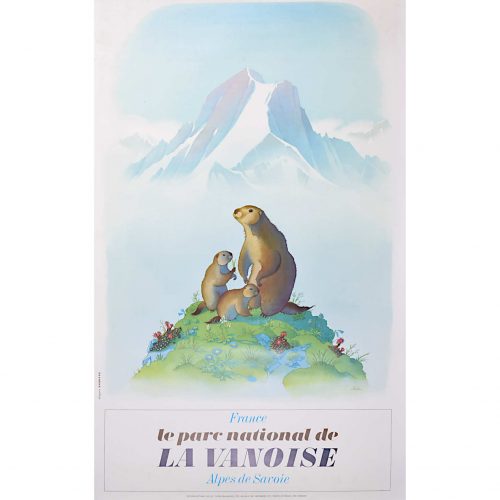
'Samivel' Paul Gayet-Tancrède (1907-1992)
Le Parc National de la Vanoise, Alpes de Savoie
Editions Mythra SA Chamonix Original Vintage Ski Poster 99x62cm Condition: Excellent, with four small glue marks to reverse not affecting image. With the ever-popular topic of skiing, Samivel here catches a Marmot atop a Vanoise hill, a mountain peak in the background. The Marmot, a squirrel-like rodent, is always a sign of the impending end of the ski season as it comes out with the warmer weather as spring approaches. Click here to see other posters by Samivel. Samivel was a writer, an artist, a photographer, an explorer and more. In 1948 he accompanied Paul Émile Victor on the first French Greenland expedition, making three documentary films in the process. His friends included Théodore Monod and Gilbert André - the latter the mayor of Bonneval-sur-Arc and one of the founders of the Vanoise National Park - and with them and others he spent his whole life aiming for the protection of the imperilled countryside. The graphic artist side of him had a life-long fascination with high mountains, and his illustrated books and series of posters of the French Alps have long been popular. If you are interested email info@manningfineart.co.uk or call us on 07929 749056. -
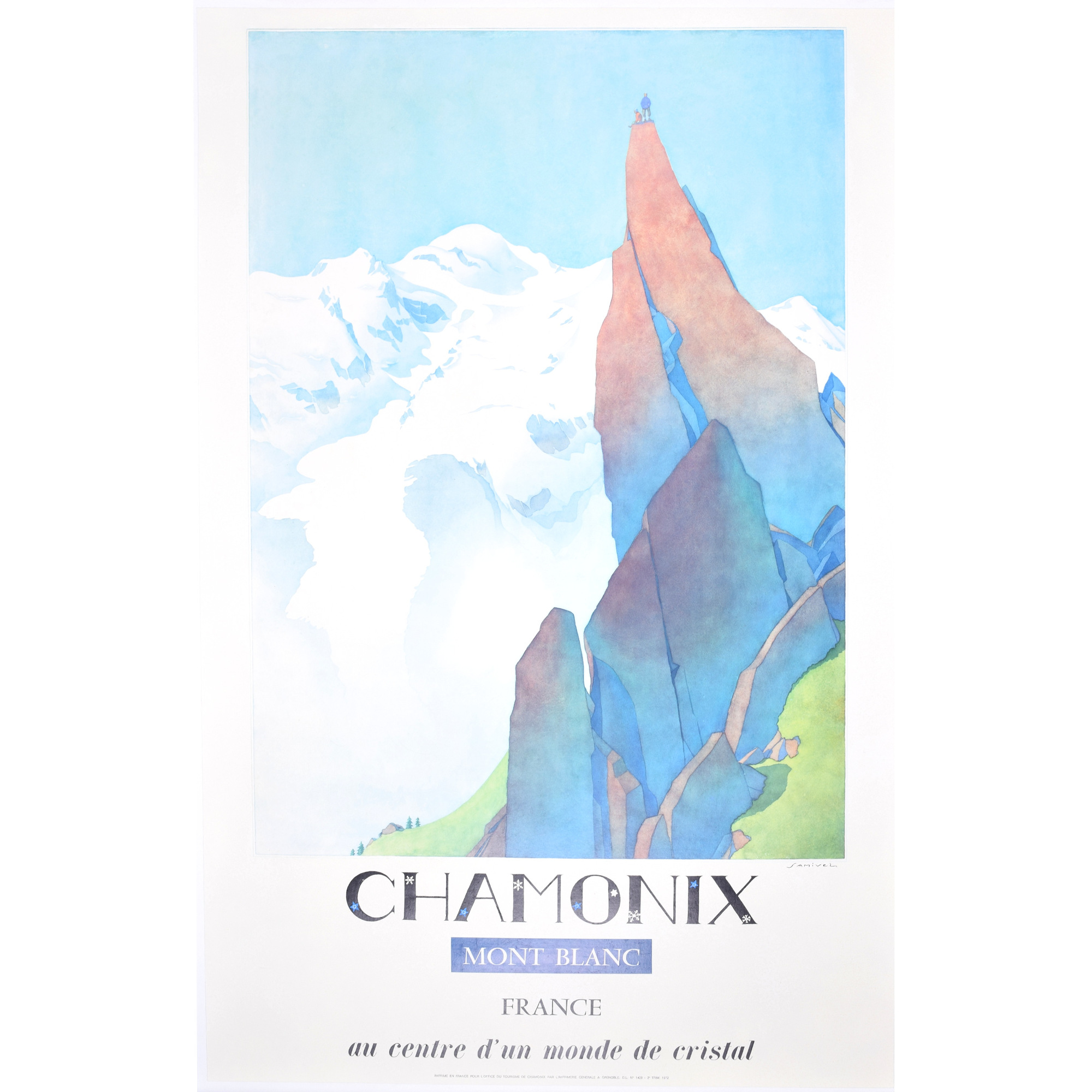
'Samivel' Paul Gayet-Tancrède (1907-1992)
Chamonix Mont Blanc, France - au centre d'un monde de cristal
Imprimé en France pour l'office du tourisme de Chamonix par l'imprimerie generale a Grenoble Original Vintage Ski Poster 99x62cm Condition: excellent With the ever-popular topic of mountains for climbing and skiing, Samivel here draws one of the Aiguille or Aiguillettes - needles - in Chamonix which are famous for climbers. Samivel was a writer, an artist, a photographer, an explorer and more. In 1948 he accompanied Paul Émile Victor on the first French Greenland expedition, making three documentary films in the process. His friends included Théodore Monod and Gilbert André - the latter the mayor of Bonneval-sur-Arc and one of the founders of the Vanoise National Park - and with them and others he spent his whole life aiming for the protection of the imperilled countryside. The graphic artist side of him had a life-long fascination with high mountains, and his illustrated books and series of posters of the French Alps have long been popular. Click here to see other posters by Samivel. If you are interested email info@manningfineart.co.uk or call us on 07929 749056. -

'Samivel' Paul Gayet-Tancrède (1907-1992)
Du Léman à La Méditerranée, La Grande Traversée des Alpes Françaises
('From Lake Geneva to the Mediterranean, La Grande Traversée of the French Alps') Imprimé en France - Printed in France 1975 Original Vintage Ski Poster 99x62cm Condition: excellent With the ever-popular topic of mountains for climbing and skiing, Samivel here draws a snow-covered col in the mountains. La Grande Traversée is a long-distance walking route from Thonon les Bains to Nice, set up in the early 1970s. Samivel was a writer, an artist, a photographer, an explorer and more. In 1948 he accompanied Paul Émile Victor on the first French Greenland expedition, making three documentary films in the process. His friends included Théodore Monod and Gilbert André - the latter the mayor of Bonneval-sur-Arc and one of the founders of the Vanoise National Park - and with them and others he spent his whole life aiming for the protection of the imperilled countryside. The graphic artist side of him had a life-long fascination with high mountains, and his illustrated books and series of posters of the French Alps have long been popular. Click here to see other posters by Samivel. If you are interested email info@manningfineart.co.uk or call us on 07929 749056. -
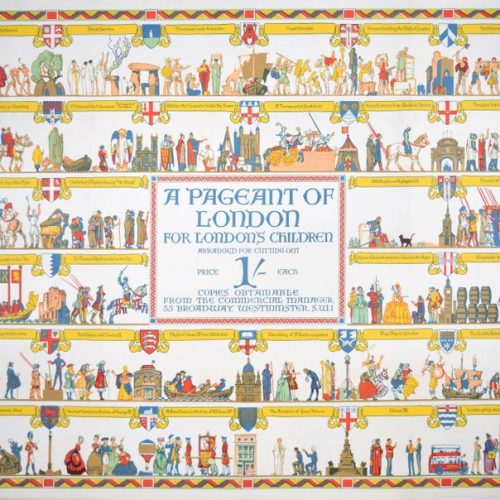
Elijah Albert Cox (1876–1955)
Pageant of London (1926)
Original London Transport Underground posterLithograph102 x 127 cmThis fantastic poster illustrates London-related events from British history, and advertises a cutting-out book designed for children.Cox was born in Islington and studied at Whitechapel People's Palace and then the London College of Printing. Having worked as an assistant to Frank Brangwyn, and as a designer for a manufacturing chemist, he became a mural and poster designer. Elected to the Royal Society of British Artists in 1915, commissions came from London Underground, the Empire Marketing Board and others. He also illustrated books - mostly historical and heroic adventures.If you are interested, please email info@manningfineart.co.uk or call us on 07929 749056. -
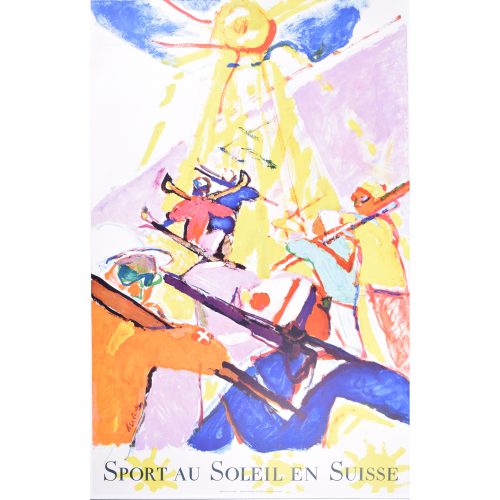
Hans Falk (1918-2002)
Sport au Soleil en Suisse
Original Vintage Poster (1957) Lithograph 40x25" Signed in the plate, and showing a procession of brightly-coloured skiers heading up the mountain towards the sun. Falk was a Swiss graphic designer who spent much of his life in the USA, UK and Ireland, producing many striking and popular posters. -
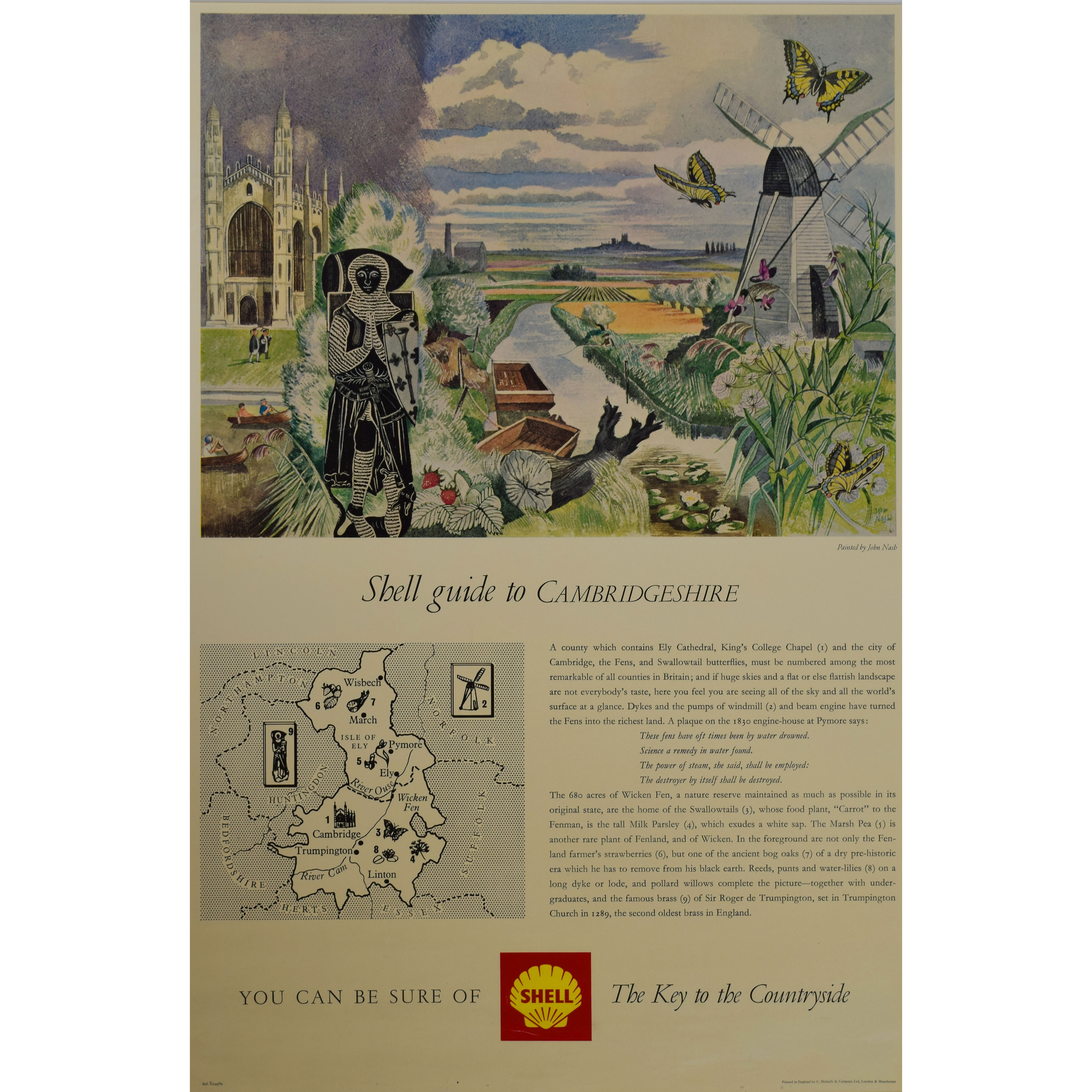
John Nash
Shell Guide to Cambridgeshire Original poster c. 1960s 76x51cm Shell commissioned a series of posters to go with their County Guide books, and they commissioned paintings by the leading artists of the day. Nash needs no introduction as an artist. A painter of landscapes and still-lives and illustrator - particularly of botanic works - who worked extensively with wood engravings, he was a natural choice for Shell. His most famous work is probably 'Over the Top' which hangs in the Imperial War Museum, relating to a counter-attack by 1st Battalion Artists' Rifles at Welsh Ridge on 30 December 1917. Of the eighty men who went over the top, sixty-eight were killed or wounded within the first few minutes. Nash escaped and painted the picture three months later. The Tate holds his 1918 painting 'The Cornfield' which was his first non-war painting (he only started painting in oils in 1914). Condition: mounted in conservation mount and wrapped in plastic sleeve (mount hides short edge tears). -
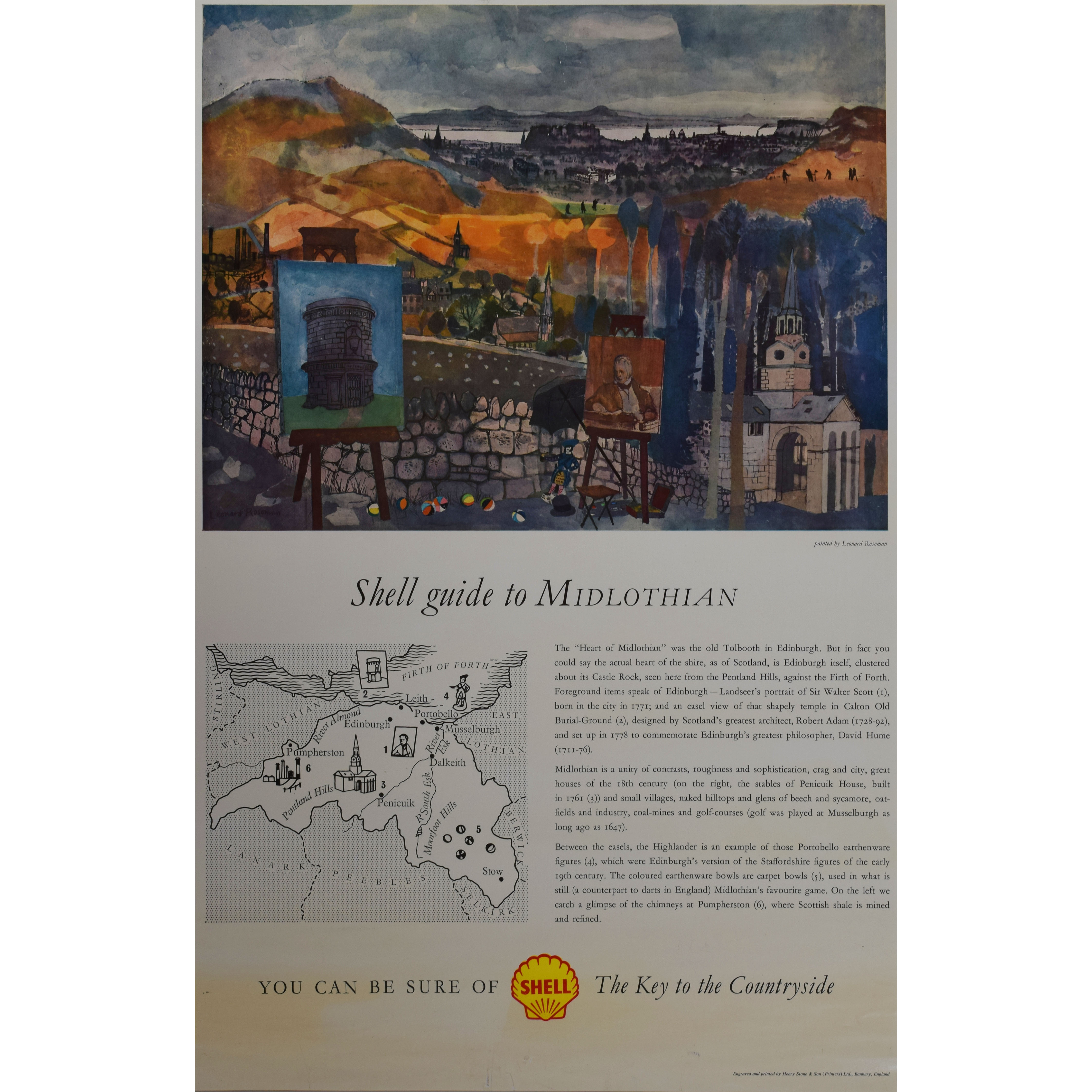
Leonard Rosoman
Shell Guide to Midlothian Original poster c. 1960s 76x51cm Shell commissioned a series of posters to go with their County Guide books, and they commissioned paintings by the leading artists of the day. Born in London, Rosoman studied at the Royal Academy Schools and then the Central School. His first major commission was to illustrate the popular children's book 'My Friend Mr Leakey' in 1937. Joining the Auxiliary Fire Service during World War II, he painted many scenes from the Blitz, some of which are in the Imperial War Museum collection. Seconded to the War Office in 1943 to illustrate books on fire-fighting the War Artists' Advisory Committee gave him a full-time post with the British Pacific Fleet, sailing with HMS Formidable the aircraft carrier. After the war he taught at Camberwell College of Art. He painted a mural for the Festival of Britain in 1951, murals for the British Pavilion at the 1958 Brussels International Exhibition, and for the restaurant at the Royal Academy's Burlington House - becoming RA in 1969. Condition: mounted in conservation mount and wrapped in plastic sleeve (mount hides short edge tears). -
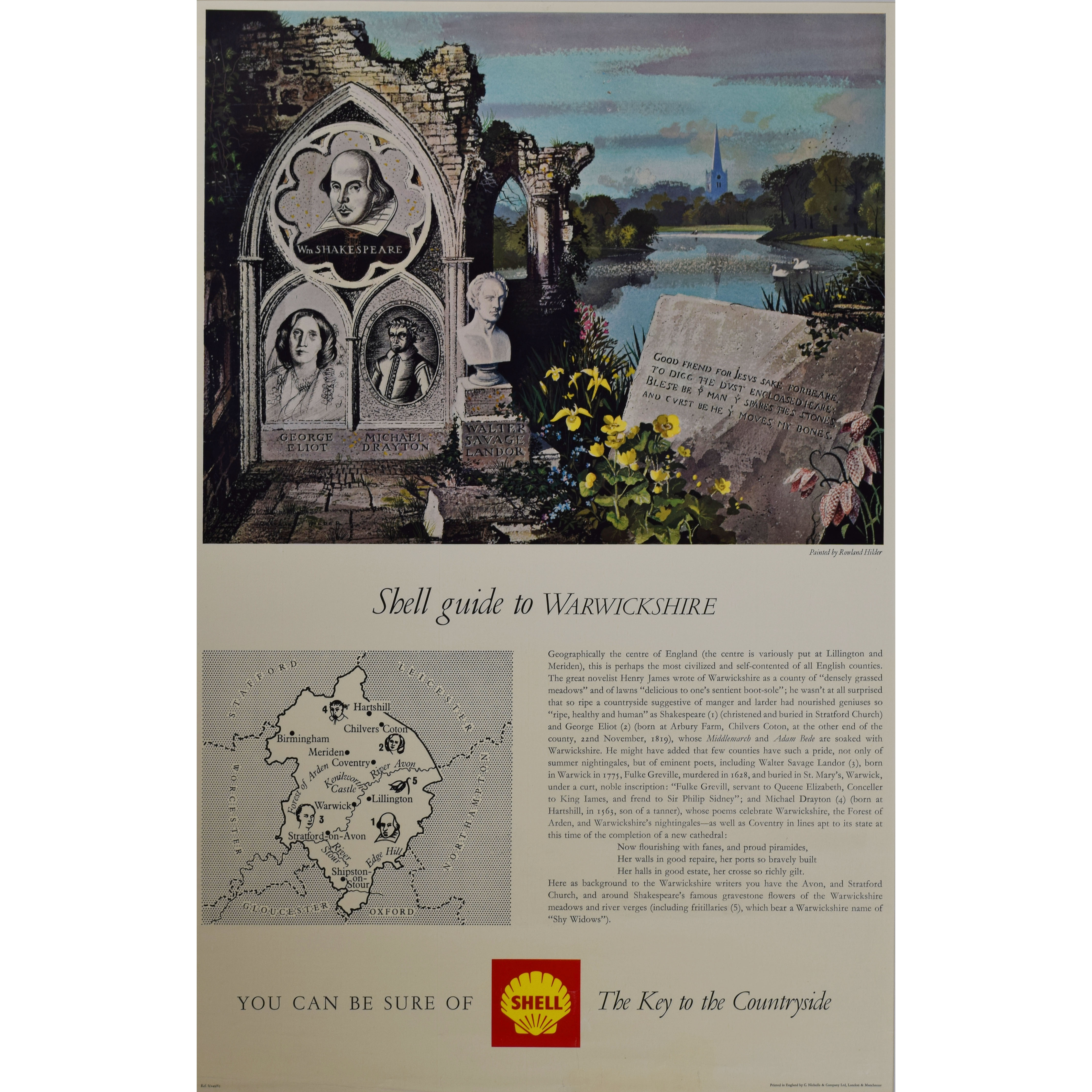
Rowland Hilder
Shell Guide to Warwickshire Original poster c. 1960s 76x51cm Shell commissioned a series of posters to go with their County Guide books, and they commissioned paintings by the leading artists of the day. Rowland Hilder was a well known landscape artist and book illustrator. Born in New York state, his English father moved the family to Kent, England in 1915. It was here his natural talent for drawing was noticed by his school. Later Hilder went to study at Goldsmith’s College in London. He was well known as an accomplished watercolorist, particularly in his sensitive handling of the sky and earth. Between 1964 and 1974 he was president of England’s Royal Institute of Painters in Watercolours. Condition: mounted in conservation mount and wrapped in plastic sleeve (mount hides short edge tears). -
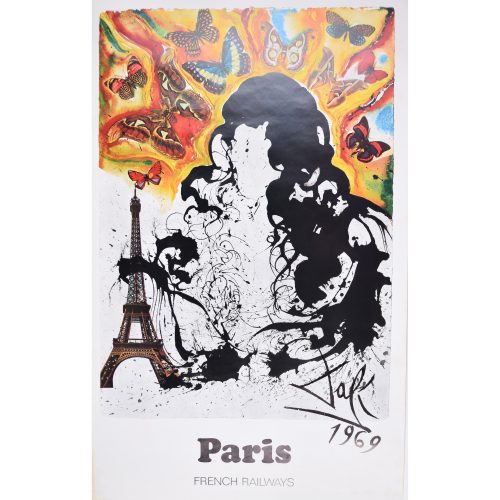
Salvador Dali (1904-1989) Paris, France - French Railways
Lithographic poster 101 x 63.5 cm For French Railways SNCF Printed by Draeger Printed in France for and by the French National Railways, 1970 Signed and dated in the stone 1969 Generally very good; occasional slight browning to the very edges -
Out of stock
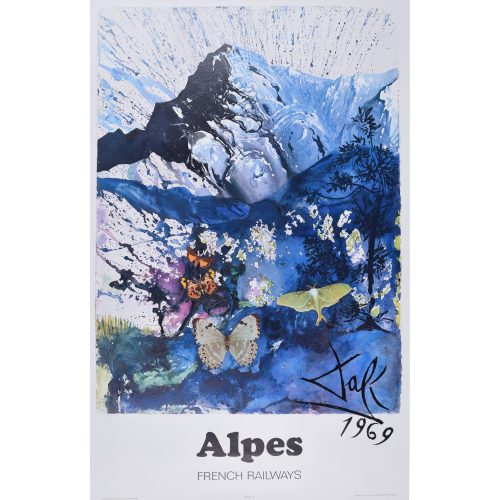
Salvador Dali (1904-1989) Alpes French Railways - The Alps
Original Poster for French Railways SNCF 40x25" (100x67cm) Printed by Draeger Printed in France for and by the French National Railways, 1970 Signed and dated in the stone 1969 Printed on wove - a thicker paper than the standard poster which is also textured. Condition: very good -

Salvador Dali (1904-1989) Alpes French Railways - The Alps
Original Poster for French Railways SNCF 40x25" (100x67cm) Printed by Draeger Printed in France for and by the French National Railways, 1970 Signed and dated in the stone 1969 Condition: very good, slight age toning/handling wear to very edges as usual -
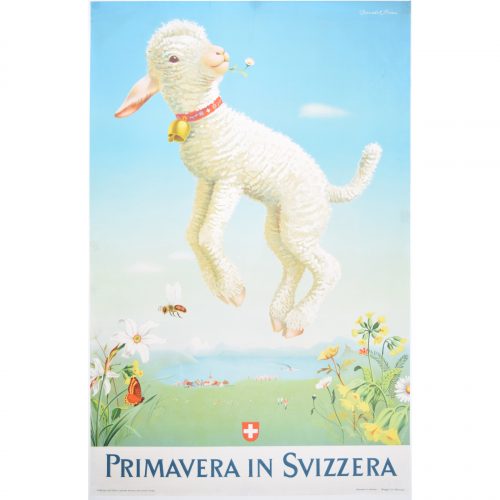
Donald Brun (1909-1999)
Primavera in Svizzera (1945) Lithographic poster Printed by Swiss National Tourist Office, Zurich 40×25 inches This poster won a Swiss Poster award in 1945 Donald Brun produced his famous series of posters for Switzerland as global travel became more possible. Here a Swiss steamer boat is seen crossing Lake Geneva (presumably) as a lamb celebrates spring, cavorting with a bee and a butterfly. -

What to Eat and Why
Original Poster 51x76cm If you are interested email info@manningfineart.co.uk or call us on 07929 749056. -
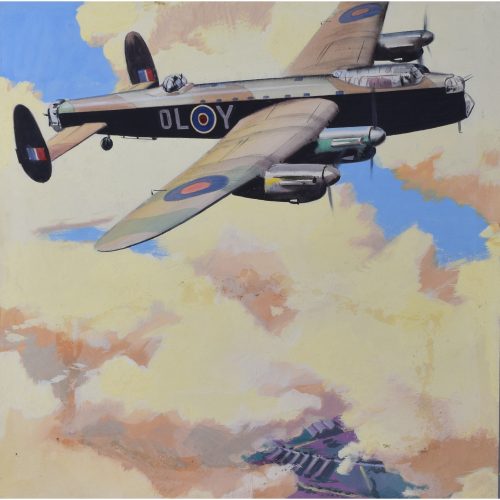
Ernest Bendell-Bayly Lancaster Bomber
Oil on paper laid on board 39x38cm Design for a poster 1940s If you are interested email info@manningfineart.co.uk or call us on 07929 749056. Ernest Bendell-Bayly was a partner in the Bayly-Souster advertising agency, employer of, amongst others, Owen Miller. They produced many posters for the Ministry of Aircraft Production during the war. -
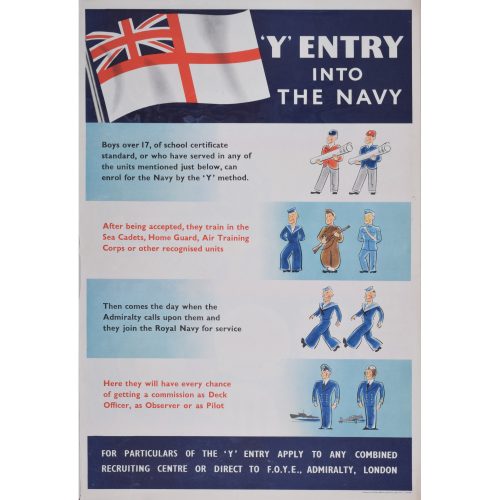
Y Entry to the Navy
Original Lithographic Poster 76x51cm If you are interested, email info@manningfineart.co.uk or call us on 07929 749056. -
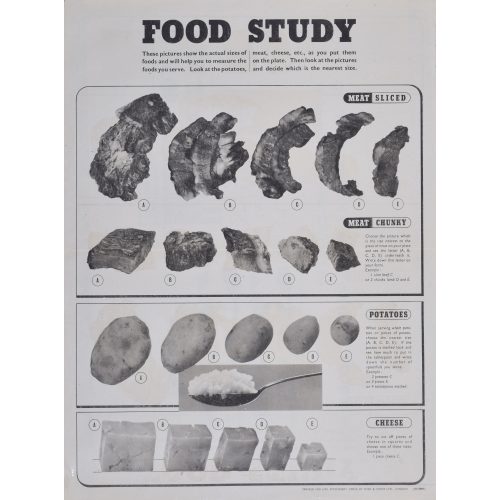
Food Study
Original Poster 51x76cm If you are interested email info@manningfineart.co.uk or call us on 07929 749056. -
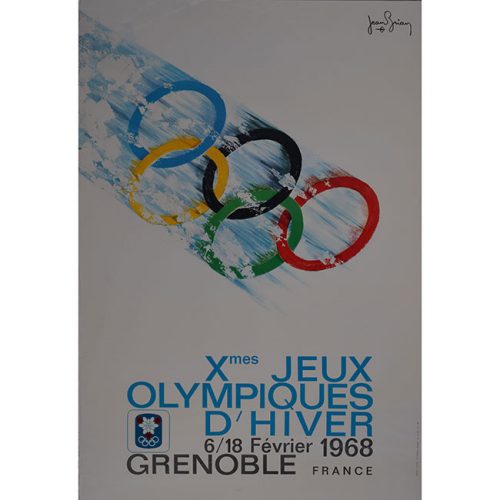
Jean Brian (1910-90)
X Jeux Olympiques d'Hiver (1968 Winter Olympics Grenoble France)
1968 Lithographic poster 95.1x 63.4cm If you are interested email info@manningfineart.co.uk or call us on 07929 749056. -
Out of stock
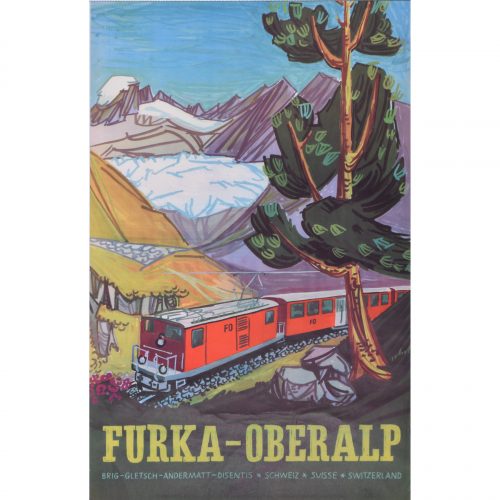
Hugo Schol (Swiss, 20th Century)
Furka Oberalp
Lithographic poster (1959) Brig-Gletsch-Andermatt-Disentis *Schweiz*Suisse*Switzerland 20x12.5" An arresting scene of the Furka Oberalp Bahn/Railway by one of the best Swiss poster artists of the period. Here in a conveniently small size, the red of the train contrasts with the vivid colours of the Alps. -
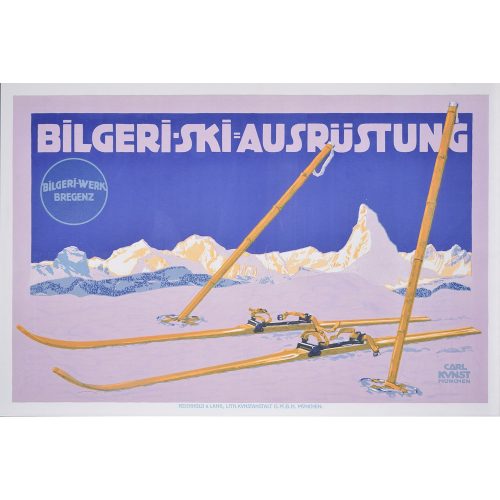
Carl Kunst (1884-1912) Bilgeri Ski Ausrüstung
51x85cm Lithographic poster Reichhold & Lang, Lith. Kunstanstalt GMBH München A view of the Matterhorn - the obvious mountain in the background - near Zermatt in Switzerland, made for Bilgeri Week in Bregenz with old-fashioned wooden skis and poles c. 1910. Bilgeri were an Austrian manufacturer of skis. If you are interested email info@manningfineart.co.uk or call us on 07929 749056. -
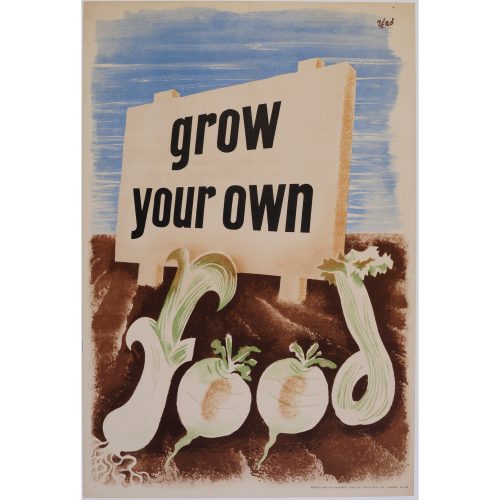
'Zero' Hans Schleger (1898-1976) Grow Your Own Food
Lithographic poster c. 1940 Printed by Fosh & Kosh Limited for HMSO 76x51cm A copy of this poster is in the collection of the Imperial War Museum. Click here for biographical details and other posters by Hans 'Zero' Schleger. Provenance: the estate of the artist. If you are interested email info@manningfineart.co.uk or call us on 07929 749056. -
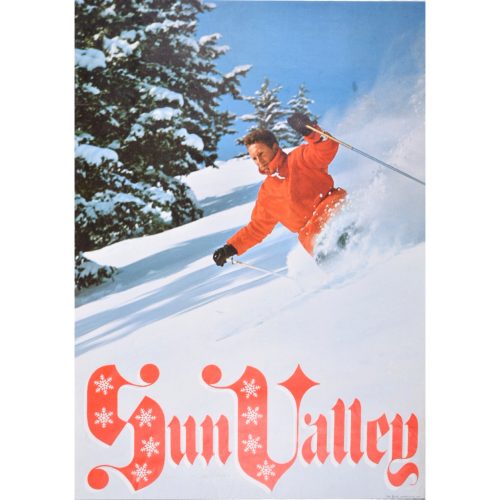
Sun Valley
Original lithographic poster c. 1965 76x51cm Published by LooArt Press, Colorado The resort was the first destination winter resort in the US and was developed by W A Harriman, the chairman of the Union Pacific Railroad to increase passenger numbers. The Austrian Count Schaffgotsch was instructed to find a suitable site and Sun Valley was born. Sun Valley was the site of the world's first chairlifts as single-seat chairs were installed in 1936 for the opening. The poster is believed to depict Sigfried 'Sigi' Engl, an Austrian who became director of Sun Valley Ski School in 1952 and made it famous for his innovative instructional methods. A few light creases and small spot towards top right. -
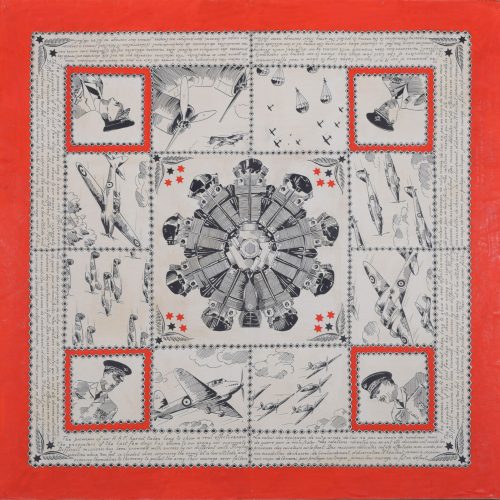
Design for Bianchini Ferier, Lyon for a scarf
Pen and Gouache c. 1940 75cm x 75cm "The prowess of our R.A.F. has not taken long to show a real effectiveness. The encounters of the last few days has sown to our enemy our supremacy. Difficult missions have been crowned with success by our different units. Flying sometime above 7000 feet in clouded skies surprising the enemy at a low altitude and exposing themselves to the enemy to protect the army. Their courage never falters." In the months prior to the Fall of France in May 1940 - before the Battle of Britain began - the RAF was in action in the skies above France and this design for a scarf depicts aeroplanes and pilots of the RAF. -
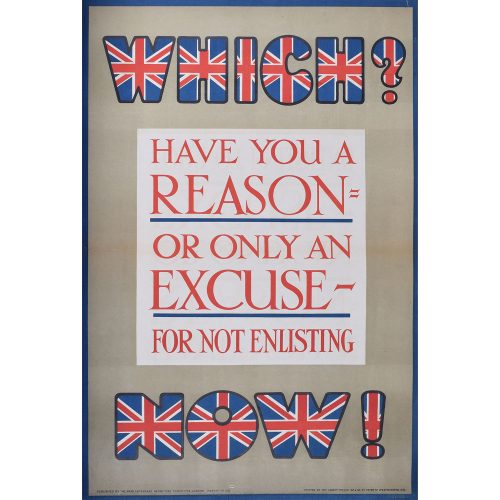
Parliamentary Recruiting Committee Which? Have you a Reason for not Enlisting - Or only an Excuse for not Enlisting. Now!
Original lithographic poster c. 1914 75 x 50cm Published by the Parliamentary Recruiting Committee, London Printed by the Abbey Press 32 & 34 Great Peter St Westminster SW Before conscription was introduced at the beginning of 1916, recruitment into the British Army was all by way of volunteering. Lord Kitchener, Secretary of State for War, wanted to recruit almost 100,000 men per month and by the end of 1915 the supply of volunteers - despite excellent posters such as this one - was drying up. -
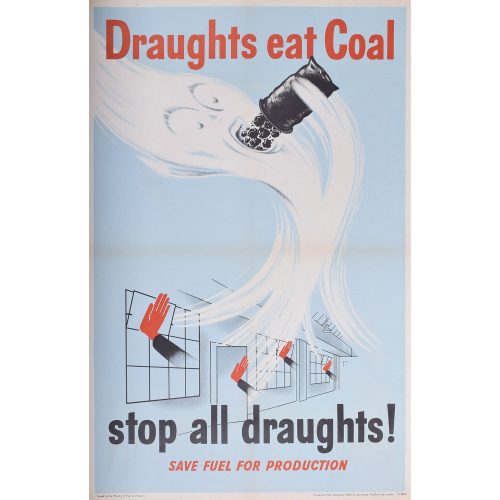
Anonymous
Draughts Eat Coal - Stop All Draughts! Save Fuel for Production
Lithographic poster 76 x 50cm Issued by the Ministry of Fuel and Power Printed for HM Stationery Office by J Weiner Ltd, London WC1 Fuel was needed for production of munitions and machinery, as well as to drive the machinery. The population was therefore exhorted not to waste fuel. Successful Home Front propaganda posters, as Fougasse proved, needed to amuse the watcher; cartoonists were accordingly highly regarded for this task. -
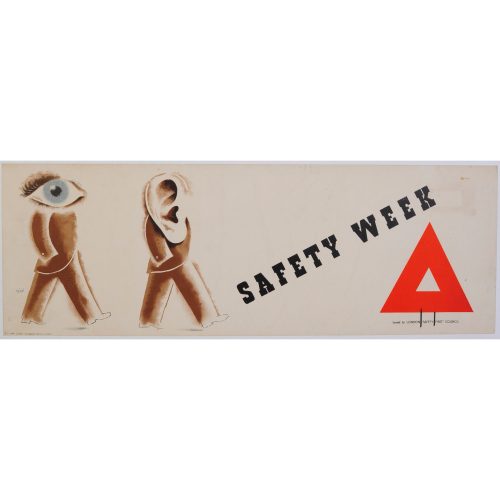
'Zero' Hans Schleger Safety Week
Lithographic panel poster 1937 Published by London 'Safety First' Council Printed by Dangerfield Printing Company Ltd A copy of this poster is in the collection of the London Transport Museum. Click here for biographical details and other posters by Hans 'Zero' Schleger. Provenance: the estate of the artist. If you are interested email info@manningfineart.co.uk or call us on 07929 749056. -
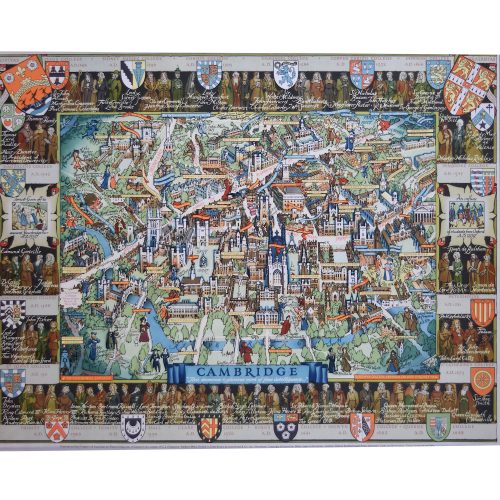
Kerry Lee (1903-1988)
'Cambridge' Original Poster Map c. 1965
45x58cm Original Vintage Lithographic poster Published by Pictorial Maps Limited, Kerry Lee's own company The first edition of this map was 1947; this is a later edition showing as it does Fitzwilliam College in its new location on the Huntingdon Road where it moved in 1963, but still referring to it as Fitzwilliam House - it became a college in 1966. Well known as a creator of pictorial maps of British cities from the mid 20th century, he generally draws a self-portrait in the bottom corner by his signature - as here, where he is seen (mustachioed and bearded, and clad in a green tunic) with his ever-faithful dog Jim. Educated at Reading Schools of Arts and Science, the Slade and the Sorbonne in Paris, he subsequently assisted his step-father, an architect named Mr Harvey, as draftsman. Following the Depression Lee set up 'Associated Artists' at Blandford Studios off Baker Street, with a group of other commercial artists. During World War 2 he was based in Hertfordshire creating detailed cut-away drawings of German aircraft, and after the war - still at Blandford Studios - published a series of pictorial maps, both those for British Rail and also his own publications. -

Fred Taylor (1875-1963)
Hampton Court by Tram (1929)
Lithographic poster backed to linen 75 x 50 cm Published by Underground Electric Railways Company Ltd, 1929, printed by Vincent Brooks, Day & Son Ltd Click here for biographical details and other works by the artist. If you are interested email info@manningfineart.co.ukor call us on 07929 749056. -
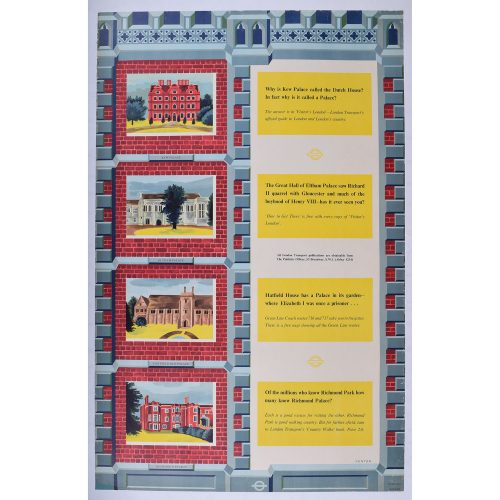
Ernest William Fenton (b. 1922)
Transport for London: Kew Palace, Eltham Palace, Hatfield Old Palace, Richmond Palace
Printed for London Transport Lithographic poster 40x25 inches Educated at Selby College of Art, Leeds College of Art and the Royal College of Art, William Fenton designed posters for London Transport from 1952-1976. If you are interested email info@manningfineart.co.ukor call us on 07929 749056. -
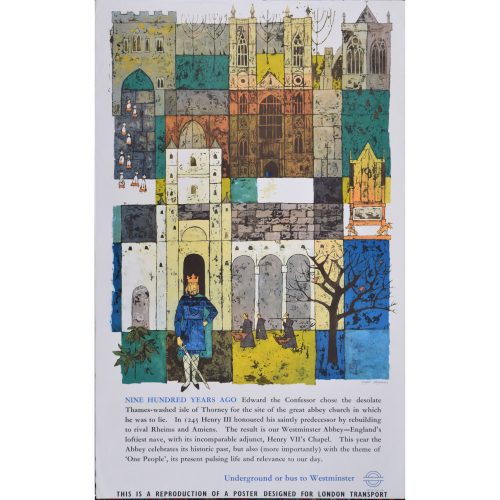
Gaynor Chapman (1935-2000)
Nine Hundred Years Ago
1966 Lithographic poster for London Transport From the original printing but sold at the time in the London Transport poster shop hence overprinted 'This is a reproduction of a poster designed for London Transport." 101×63.5cm Chapman attended the Epsom School of Art and the RCA where she studied illustration and graphics. Her posters for London Transport are amongst her best works. If you are interested email info@manningfineart.co.uk or call us on 07929 749056. -
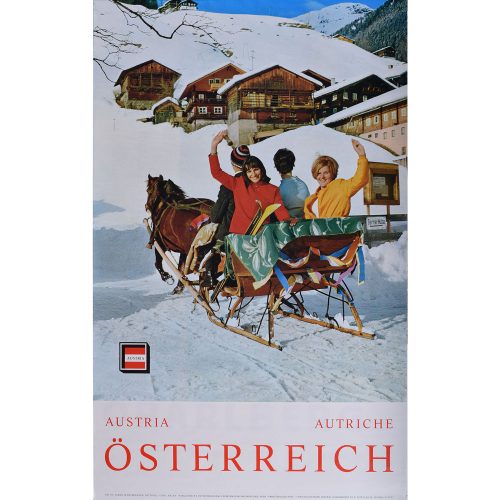
Austria: Osterreich
Lithographic poster 81x50cm If you are interested email info@manningfineart.co.ukor call us on 07929 749056. -
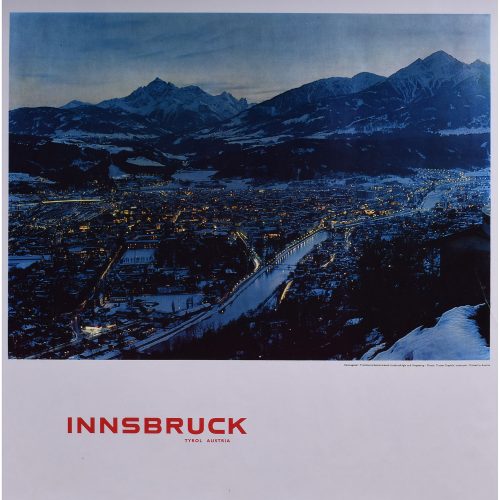
Innsbruck Tyrol Austria
Lithographic poster 47x47cm If you are interested email info@manningfineart.co.uk or call us on 07929 749056. -

Vorarlberg Austria
Lithographic poster Printed G Gistel 81x50cm If you are interested email info@manningfineart.co.ukor call us on 07929 749056. -
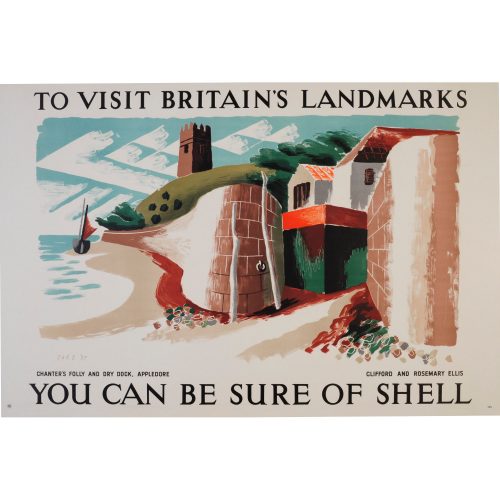
Clifford and Rosemary Ellis
You can be sure of Shell
Chanter's Folly and Dry Dock, Appledore
Lithographic poster for Shell Mex BP (1937) 30x44" Provenance: the family of the artist, by descent. Condition: A/A- backed to linen. Click here for biographical details and other works by the artist. Shell produced a large series of posters in the 1920s and 30s to encourage motorists to use their products in that early and golden age of motoring. They often commission artists not known for their commercial art, so their posters very often featured large and dramatic views of the British countryside and landmarks, inspiring motorists to travel further afield. Here the Ellises have taken a well-known landmark and applied avant-garde artistic techniques so stylising the view, turning, e.g. the clouds into an array of angular v-shaped blocks. Thomas Burnard Chanter (1797-1874) was owner of a fleet of sailing vessels and erected a signal tower ('Chanter's Folly') to give him advance notice of his vessels' arrival. It was demolished in 1952. The dry dock - Richmond dry dock - was built in 1853 and designed to hold two 'large' ships. It exists today and is Grade II listed. If you are interested email info@manningfineart.co.uk or call us on 07929 749056. -

Salzburg: Land of Happy Holidays
Lithographic poster 84x59cm If you are interested email info@manningfineart.co.ukor call us on 07929 749056. -
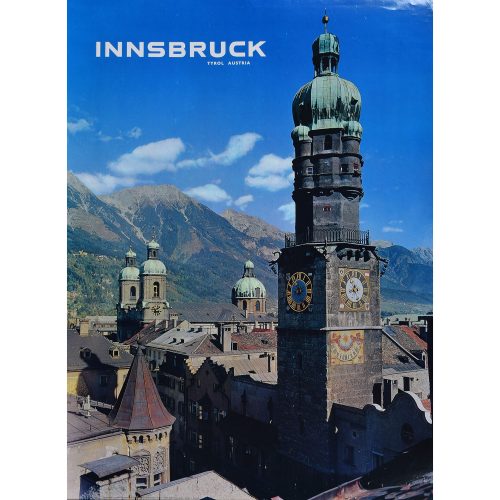
Innsbruck: Austria
Lithographic poster Printed Tiroler Graphik 70x50cm If you are interested email info@manningfineart.co.ukor call us on 07929 749056. -
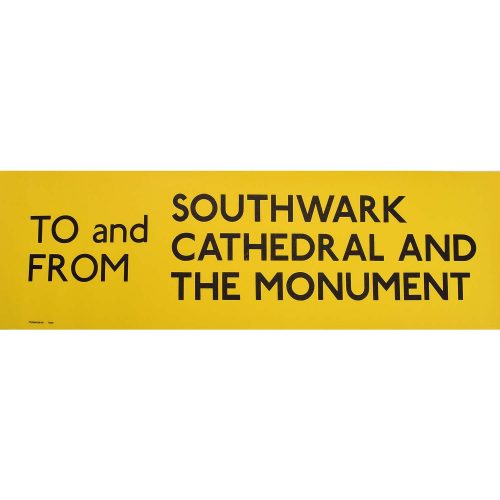
Southwark Cathedral and the Monument London England Routemaster Bus sign c. 1970
Screenprint poster 64x19cm Printed for London Transport for use on Routemaster or RT busses. If you are interested email info@manningfineart.co.uk or call us on 07929 749056. Condition: Excellent. -
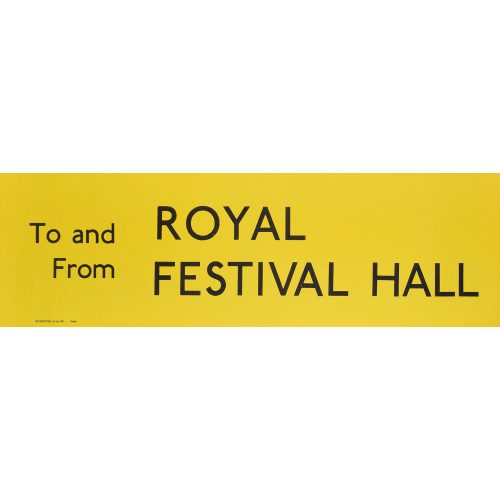
Royal Festival Hall Routemaster Slipboard Poster c1970
Screenprint poster 64x19cm In a black hand-finished frame. Printed for London Transport for use on Routemaster or RT busses. If you are interested email info@manningfineart.co.uk or call us on 07929 749056. -
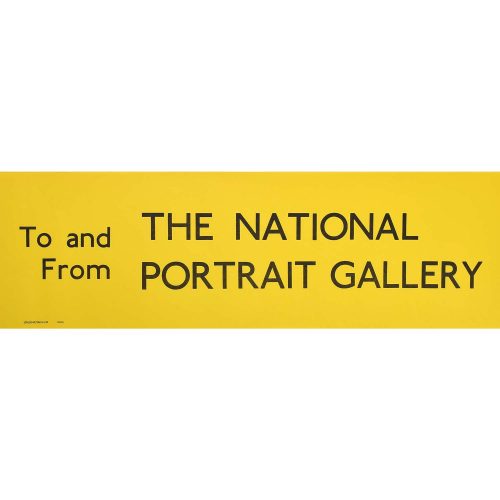
National Portrait Gallery Routemaster Slipboard Poster c1970
Screenprint poster 64x19cm Printed for London Transport for use on Routemaster or RT busses. If you are interested email info@manningfineart.co.uk or call us on 07929 749056. Condition: Excellent

